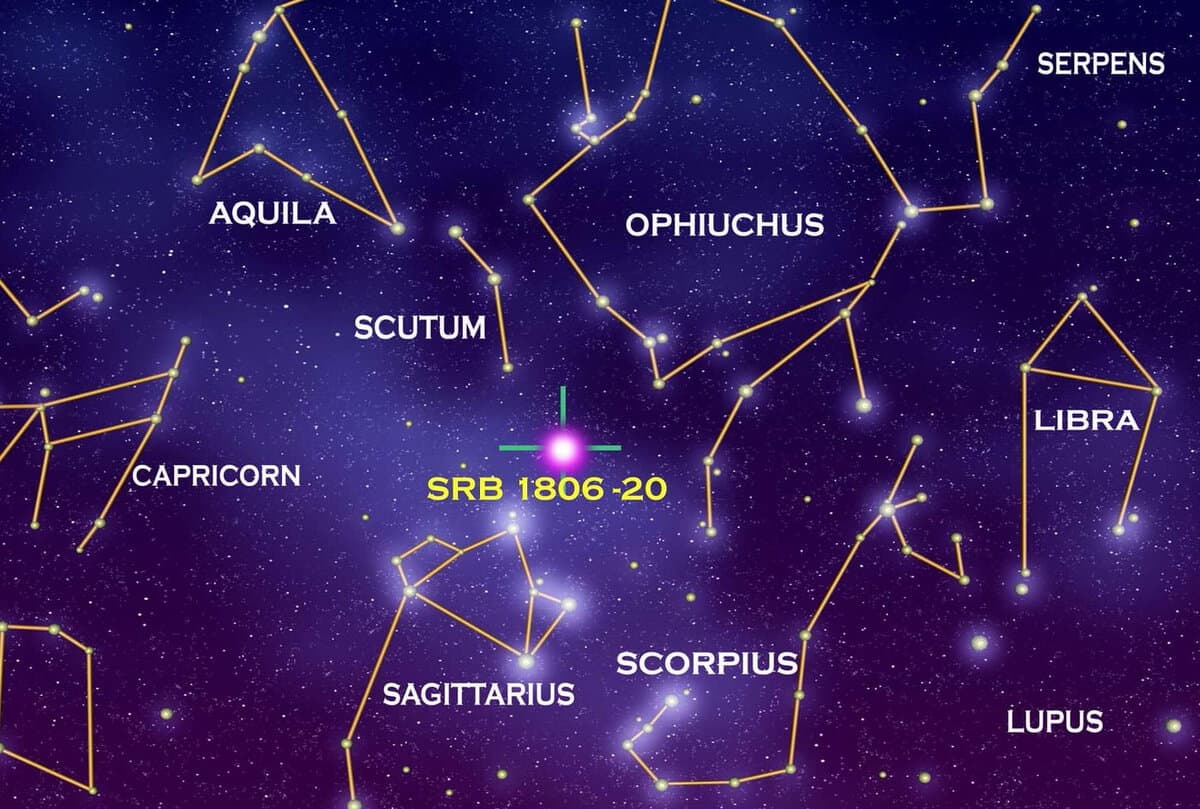
The starry sky was once used as a navigational tool for travelers. Ancient people created patterns out of the brightest stars and assigned them names based on Greek mythology, animals, and objects. As new stars were discovered, the boundaries of these constellations were adjusted. However, in 1935, astronomers made the decision to no longer revise the established boundaries.
Constellation
A constellation is commonly defined as a group of stars that are relatively close to each other. However, this definition is not entirely accurate. Let’s provide a more precise explanation of what a constellation truly is.
In modern astronomy, a constellation refers to specific regions in the sky that contain the traditional constellations. There are a total of 88 such regions. The division into regions has facilitated celestial navigation by providing a systematic framework. Each region encompasses numerous stars and galaxies, including those that do not traditionally belong to the associated constellation.
The primary constellations
The Big Dipper and Little Dipper constellations have historically held significant importance for the Northern Hemisphere. These constellations have enabled precise navigation and orientation by utilizing Polaris, the North Star. Additionally, another prominent constellation that can always be observed in the night sky is Cassiopeia.
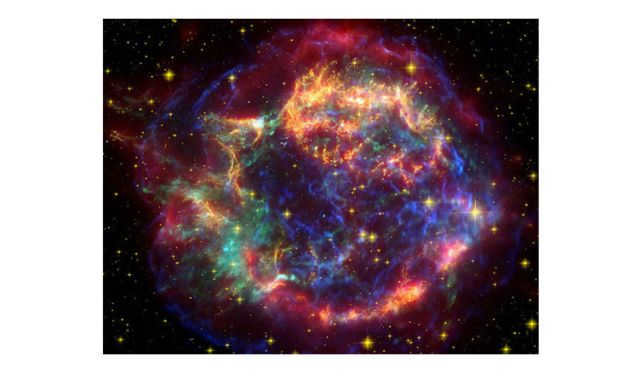
The Southern Hemisphere utilizes the Southern Cross as a distinctive feature to ascertain the direction towards the southern region. This particular constellation is not observable north of the Tropic of Cancer, which is the boundary marking the Northern Tropic.
The arrangement of stars in the Big Dipper constellation
The Big Dipper constellation consists of 7 bright stars that are arranged in a shape resembling a shallow ladle with a long curved handle. Within this constellation, there are over 200 stars and more than 3000 galaxies. It is fascinating to note that the light from the most distant star in this constellation takes approximately 13 billion years to reach Earth, and this information has been obtained through observations made by the Hubble Space Telescope.
A unique feature of the Big Dipper constellation is that if you extend the line formed by the opposite side of the ladle, it will lead you to Polaris, also known as the North Star. By drawing a perpendicular line from Polaris to the horizon, you can determine the direction of north. Polaris is also the end of the handle of the Little Bear’s dipper, which is a less bright constellation compared to the Big Dipper.
The constellation contains 5 stars in its inner group, while the movement of the 2 outermost stars is oriented in the opposite direction. It is predicted that the configuration of the Big Dipper will change in approximately 100,000 years.
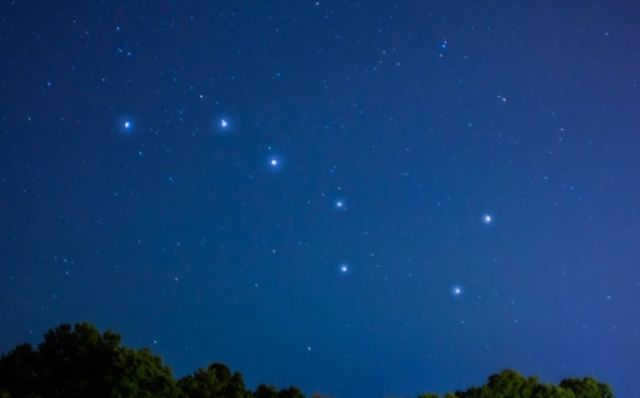
The constellation Southern Cross
The Southern Cross constellation is located in the smallest area of the night sky. It is characterized by four prominent stars that form the shape of a cross. This cross is composed of a longer horizontal bar and a shorter vertical bar. By extending the length of the longer bar by 4.5 times, a line perpendicular to the horizon can be used to determine the direction of the south.
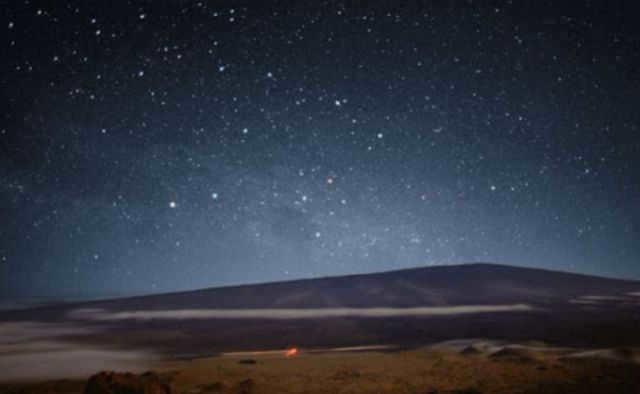
Records of this star formation can be found in the writings of the ancient Roman philosopher Ptolemy (2nd century). In this constellation, one can easily observe the dark Coal Sack Nebula and the Diamond Box star cluster, which consists of over 100 stars.
Until 2000 B.C., the Southern Cross could be seen from the area that is now known as Russia. However, it will not appear in the sky again until the year 14000.
What new knowledge have we acquired?
There are celestial formations visible in the skies of both the northern and southern hemispheres that serve as indicators of the north and south positions. These formations, known as constellations, have been briefly outlined in the preceding piece. An anecdote detailing the constellations Ursa Major, Ursa Minor, and Crux can be incorporated into a second-grade environmental lesson focused on the topic of “Determining North and South Using the Stars.”
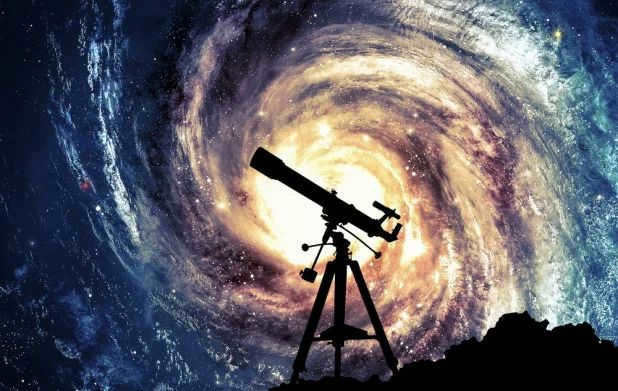
When you gaze at the night sky or in the late evening, an astonishing sight awaits you – a myriad of around three thousand shimmering luminous dots. These captivating celestial entities can exist in solitary brilliance or come together in harmonious constellations, which serve as divisions of the vast Universe. Each of these celestial bodies possesses its own unique appellation and is often associated with a distinctive conventional form.
The Sparkling Night Sky
When gazing at the night sky, particularly during the late evening, one can behold a mesmerizing spectacle of up to three thousand shimmering white lights. These enchanting lights are celestial entities, which can exist individually or form constellations. Constellations are groupings that categorize the vast expanse of the Universe and possess distinct names and conventional shapes.

Prior to the emergence of planets, the solar system consisted of cosmic dust and gases. Approximately 4.6 billion years in the past, these materials condensed to create the Sun and accompanying celestial bodies. Certain of these entities are observable within the expanse of the heavens.
As night falls, the initial glimmering dot that emerges in the celestial sphere is Venus. Being situated closer to the Sun than Earth, this planet is capable of reflecting the radiance emanating from the colossal star, thereby illuminating the darkness with a brilliance surpassing that of its planetary counterparts.
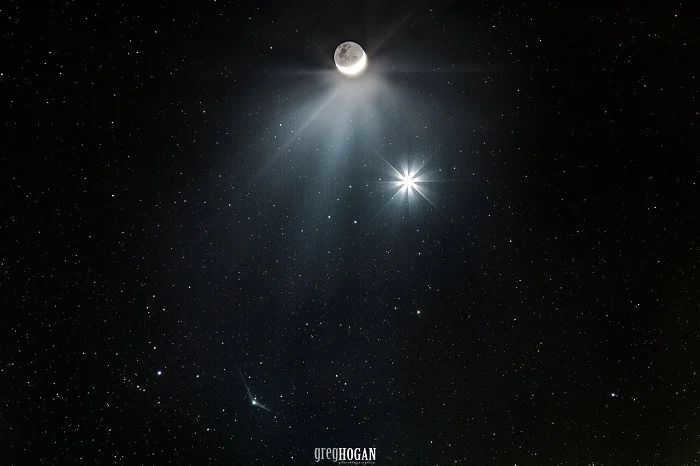
The celestial bodies visible to the unaided eye are just a small portion of the vast expanse of the universe. Nonetheless, there exist numerous astronomical entities that are observable without the use of telescopic assistance:
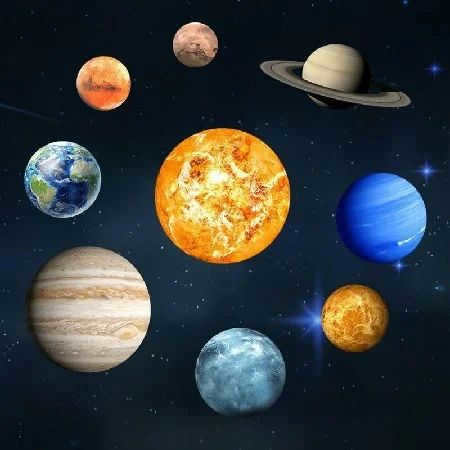
In order to observe giant celestial objects that are far away from Earth, it is necessary to use specialized equipment as they cannot be seen with the naked eye.
However, there is one exception to this rule – the Andromeda Nebula. Despite being located 2.5 million light-years away from Earth, it can actually be observed in the starry sky during the late hours of the day.
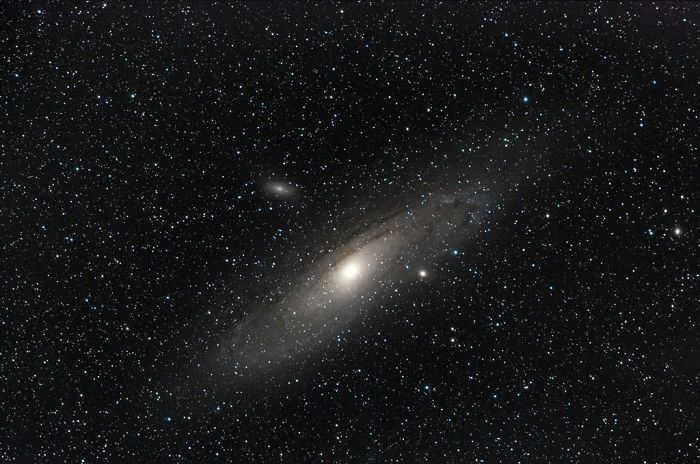
The Triangle Galaxy, which can also be observed without the use of a telescope, is situated approximately 2.7 million light-years distant from our Solar System. Its structure is characterized by a spiral form.
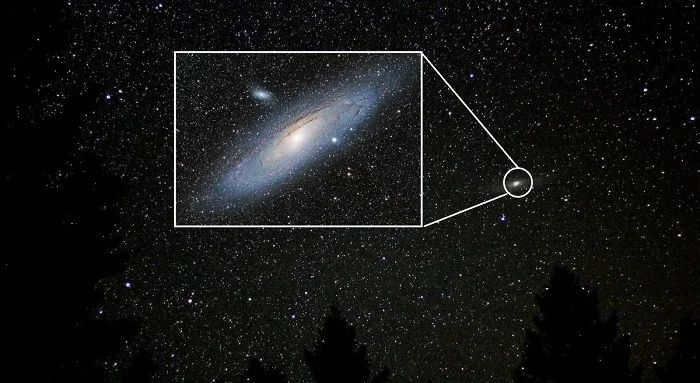
Meteor showers (observing the stars)
A meteor shower is an occurrence when a cluster of meteors enters the planet’s atmosphere. This event is visible at any time of the year and in any location around the globe.
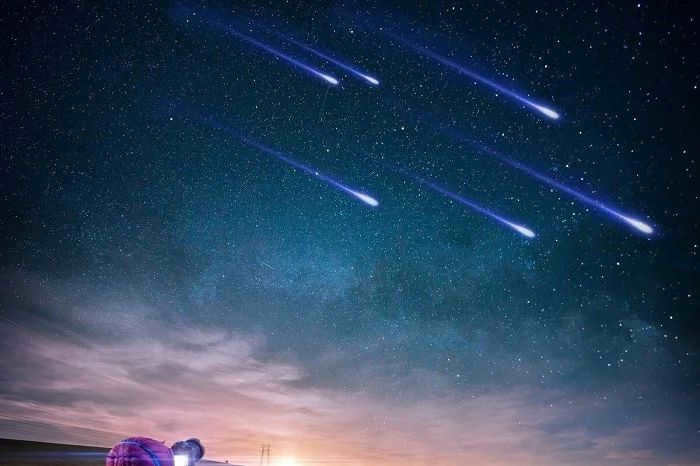
The Moon is Earth’s nearest celestial satellite and the sole astronomical body visible in intricate detail to the unaided human eye.

In the sky full of stars, one can also catch a glimpse of the International Space Station. This man-made satellite was sent into the orbit of our planet back in 1998.

If you’re fortunate, you might catch a glimpse of the spaceship trailing the station. Both entities appear as twin stars gracefully gliding in close formation.
A comet is a heavenly body resembling a star, leaving in its wake a radiant streak resembling a “tail”.
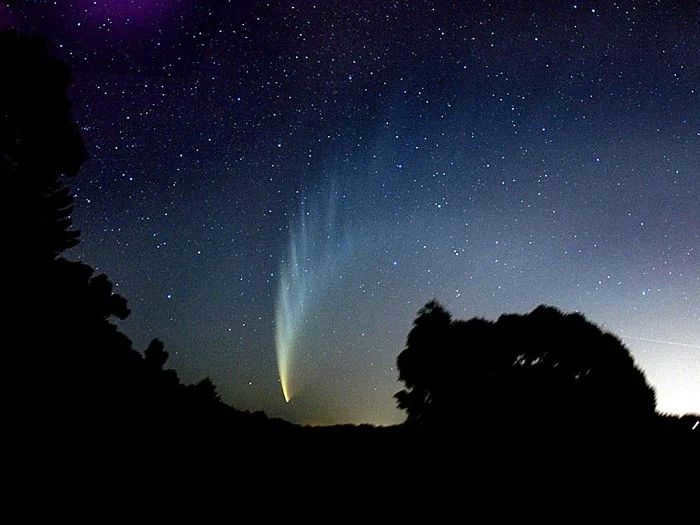
Nevertheless, the stars are the most common celestial objects visible in the night sky – they are massive spheres of hot gases.
The Origin of Stars
A star is created from a dense cloud of cosmic gas found in interstellar space. It rapidly spins, expands in size, and its temperature and luminosity increase.
The first stars emerged approximately 180 million years after the birth of the universe, around 14 billion years ago.
The nearest star to Earth is the Sun, which is around 4.5 billion years old.
The Composition of Stars
During the initial stages of their formation, stars primarily consist of various gases:
- The most abundant element in the universe, hydrogen;
- Helium;
- Carbon;
- Nitrogen;
- Oxygen.
In larger stars, elements such as iron and other solids can be produced.
It is interesting to note that while stars may appear white, their color is actually influenced by their surface temperature.
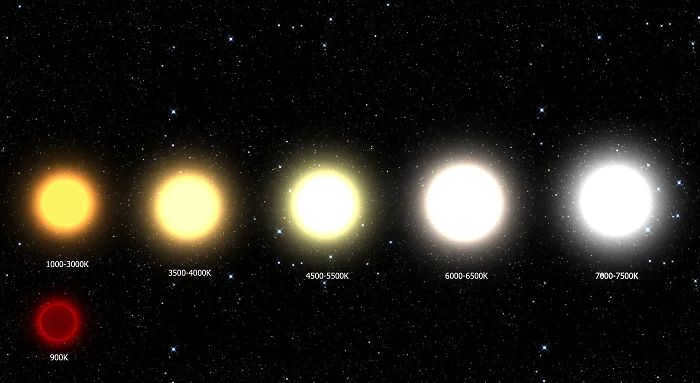
- Therefore, the most sizzling among them are known as blue stars;
- Average temperature is possessed by the white celestial stars;
- Stars with low surface temperatures are categorized as yellow and orange stars.
Different Kinds of Stars
Protostars
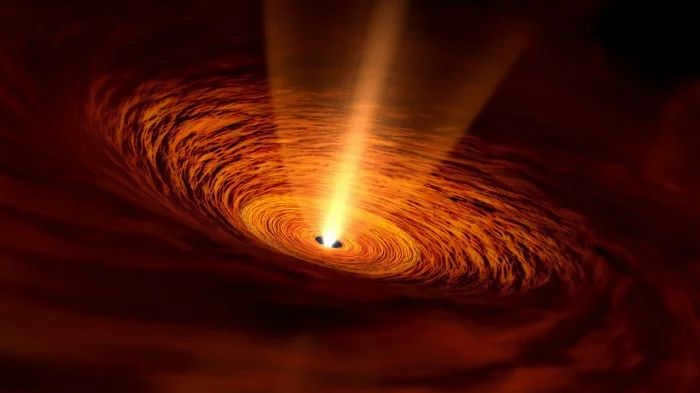
This is a collection of gas that has yet to coalesce into a complete star. The process of this celestial body’s development lasts for approximately ten thousand years.
T Tauri stars
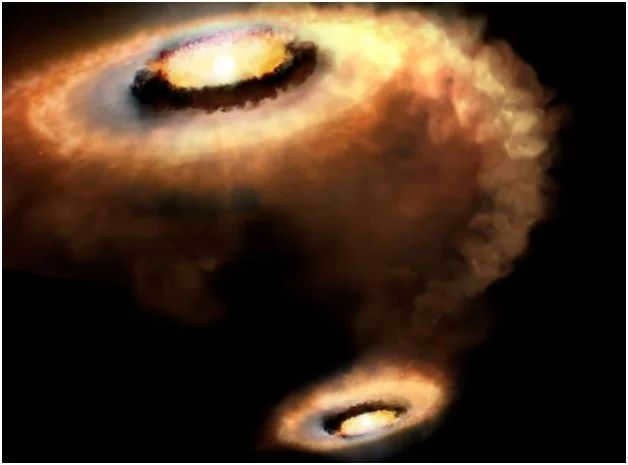
T Taurus-type stars represent the subsequent phase in the development of a complete celestial entity. They have the ability to exhibit massive sunspots, X-ray bursts, and intense wind outbursts. This particular stage lasts for approximately one hundred million years.
Stars in the main-sequence
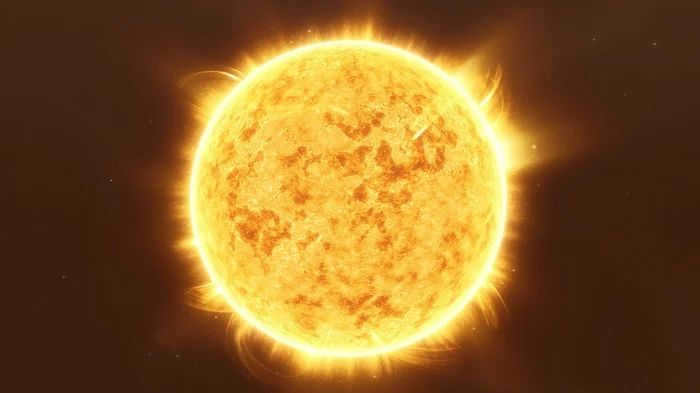
These celestial objects vary greatly in size, weight, and luminosity, but they all undergo a single operation: converting hydrogen (a main element of young stars) into helium.
Ruby giants
Red giants are characterized by their low temperature yet high brightness.
White dwarfs
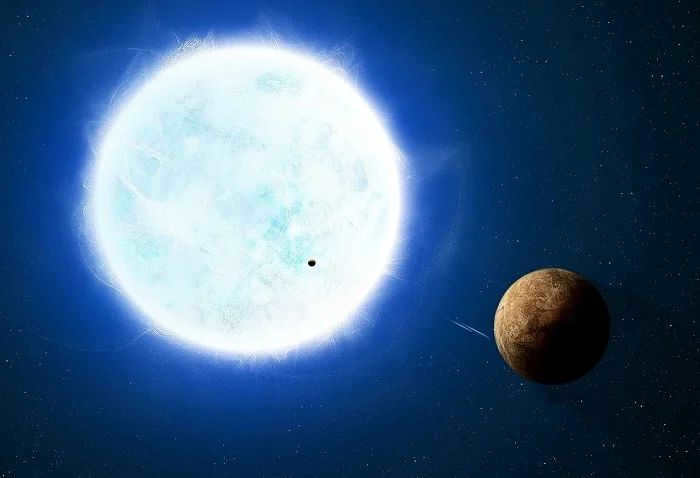
Runaway dwarfs are stars that are unable to progress in their evolution because they lack sufficient mass and energy. These celestial bodies continue to emit light as they still maintain a certain temperature.
Red dwarfs

The most prevalent kind of stars are red dwarfs. They possess lesser masses and longer lifespans. The reality is that red dwarfs consume energy at a sluggish pace and can endure for approximately ten trillion years.
Neutron stars
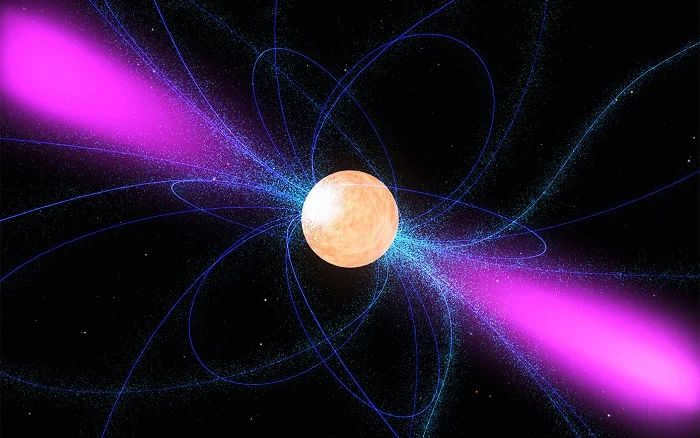
When a star finishes its life cycle, it leaves a core behind that gets compressed by charged particles called electrons. This compression results in the creation of a neutron star, which possesses a powerful magnetic field.
Supergiant Stars
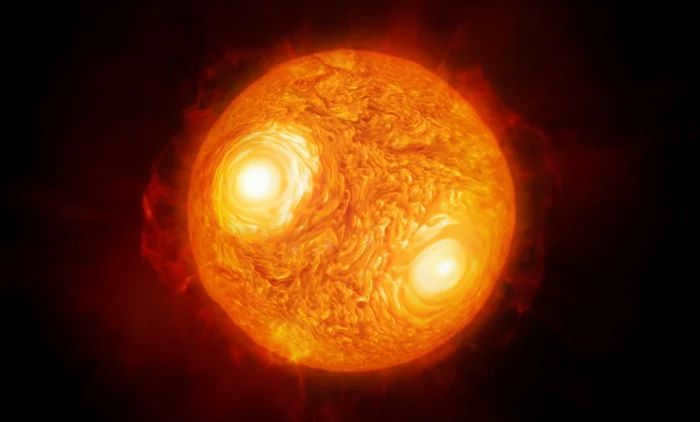
These stars are the biggest ones with masses that are tens of times greater than the sun. Super giants have relatively short lifespans (a few million years) as they consume their internal fuel.
Brown dwarfs
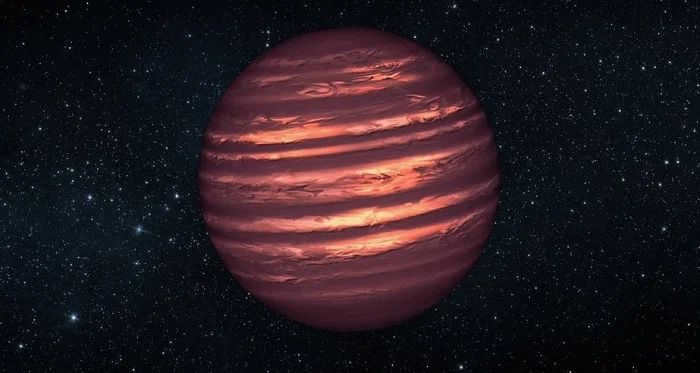
Brown dwarfs, also known as failed stars, are celestial objects that fall between planets and stars in terms of size. These enigmatic entities originate from the collapse of gas clouds.
For a considerable period, the existence of brown dwarfs was regarded as a mythical concept until the year 1995 when researchers made the groundbreaking discovery of the first known specimen.
What do we mean by constellations?
Consisting of numerous stars, galaxies are known to cluster together in the form of constellations. These constellations are formed by the combination of dust, gas clouds, and celestial objects that are brought together due to the force of attraction.
Well-known constellations and their names
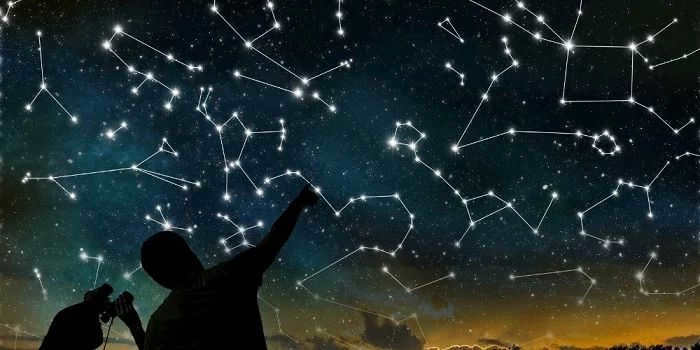
Every day, individuals have the opportunity to observe constellations in the celestial sphere. Among the most remarkable and renowned ones are:
The Big Dipper and the Little Dipper constellations
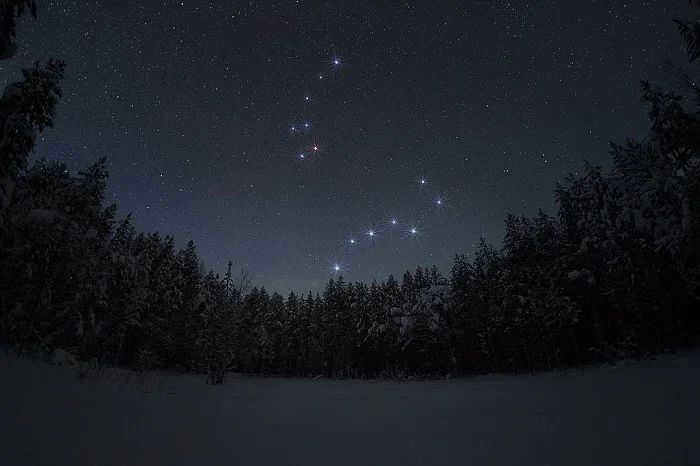
Their unique shape, similar to a spoon, has made them well-known. These constellations are most visible in northern regions all year round.
At the tip of the “handle” of Ursa Minor is Polaris, also known as the North Star. It has been a guiding light for many explorers, helping them navigate and find their way back home. Being located above the North Pole, Polaris can be used as a substitute for a compass, providing direction to different parts of the world.
About the Cassiopeia Constellation
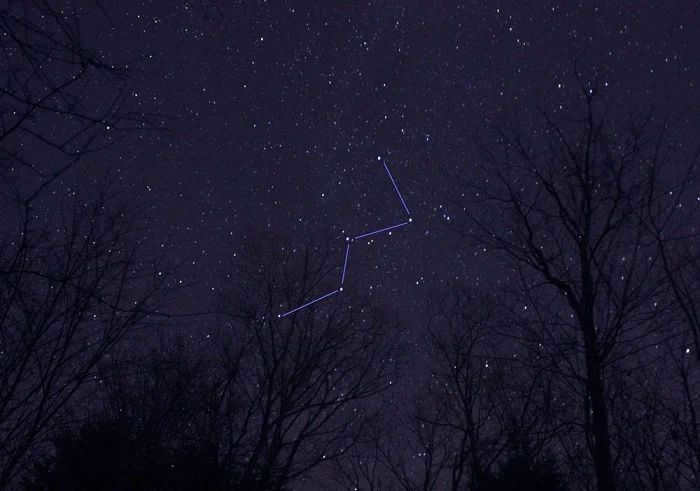
One unique characteristic of the constellation is that the primary stars of Cassiopeia are positioned in the shape of the letter “M”.
Furthermore, it was given the name Cassiopeia in honor of the mythical heroine.
The constellation Orion
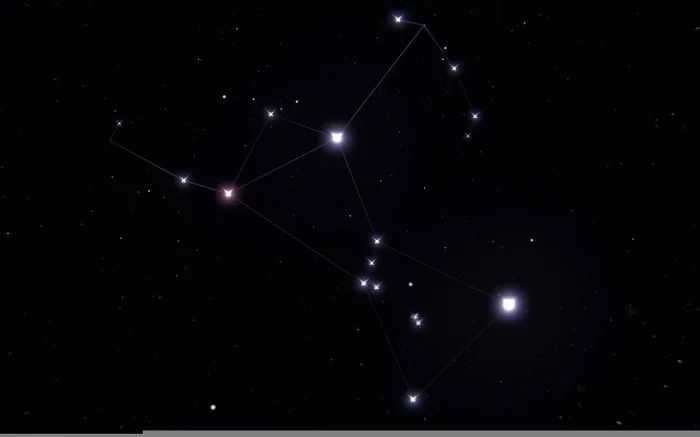
An easily recognizable constellation in astronomy is known as Leo. It stands out due to the presence of three blue stars, which are evenly spaced and aligned in a straight line.
Leo, the Lion
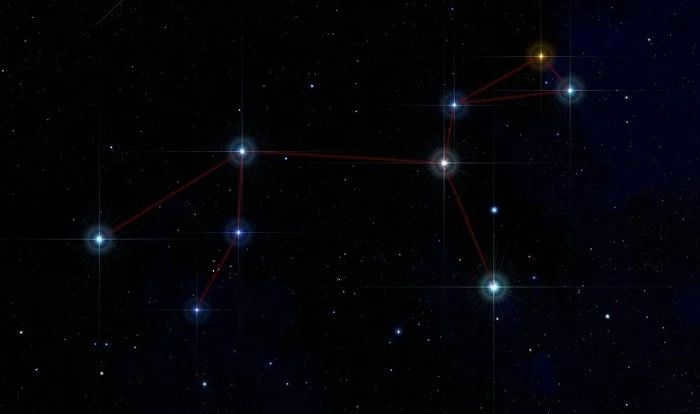
The configuration of the celestial bodies within this star grouping bears a striking resemblance to that of a lion. Near the base of the formation lies the blue-white celestial object known as Regulus (a name derived from the Latin word for “king”), which is also commonly referred to as the “heart of the Lion.”
The star grouping known as Virgo
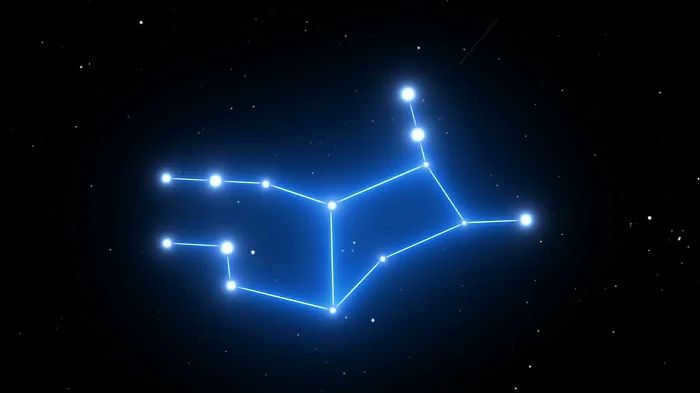
Astronomers find this particular constellation fascinating due to the presence of approximately two and a half thousand galaxies in its upper right corner. Despite its relatively small size, this region is teeming with numerous star systems.
It is worth noting that the positions of the stars remain unchanged over the years. Therefore, even in ancient times, people assigned names to the constellations that are closest to our solar system, which are still recognizable to us today.
During the mid-1900s, researchers officially documented a total of eighty-eight constellations, with over half of them (up to 54) visible to the naked eye.
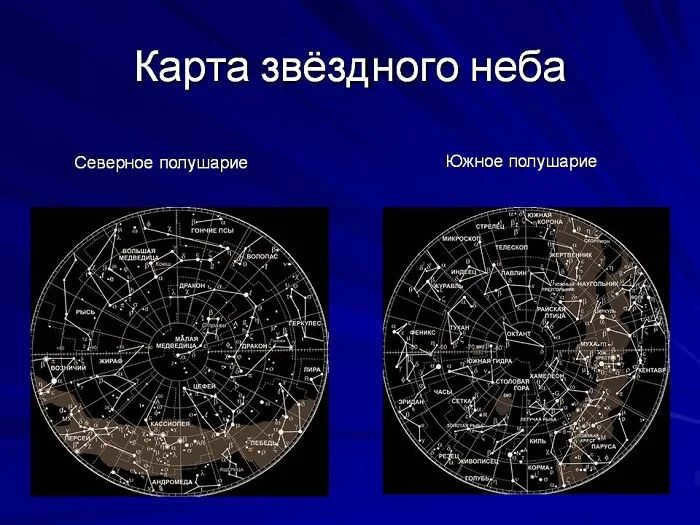
Stellar sky chart
What is the name of the constellations in astronomy
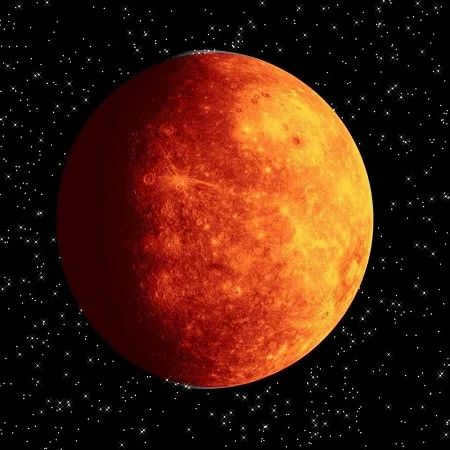
Mercury is known as the nearest planet to the shining star in the sky.
What makes it unique is the extreme variation in its temperatures. Due to the lack of an atmosphere, Mercury is unable to retain heat, causing the surface temperature to rise up to 450 degrees during the day and plummet to minus 170 degrees at night.

Venus is often referred to as the “sibling of Earth” due to its nearly identical mass and size. The planet boasts a dense atmosphere, enveloped in a thick layer of white clouds, and its atmospheric pressure is a staggering ninety times greater than that of Earth.

The presence of life is exclusive to Earth among all the planets in our solar system. There are several factors that contribute to its emergence:
-Around 70% of Earth’s surface is covered by water;
-The planet is situated at a moderate distance from the Sun, neither too close nor too far;
-Earth possesses an atmosphere, ample reserves of fresh water, fertile soil, and other conditions that are conducive to the origin of life.

Mars, also known as the “red planet,” is a celestial body in our solar system that shares some similarities with Earth:
– It has polar ice caps;
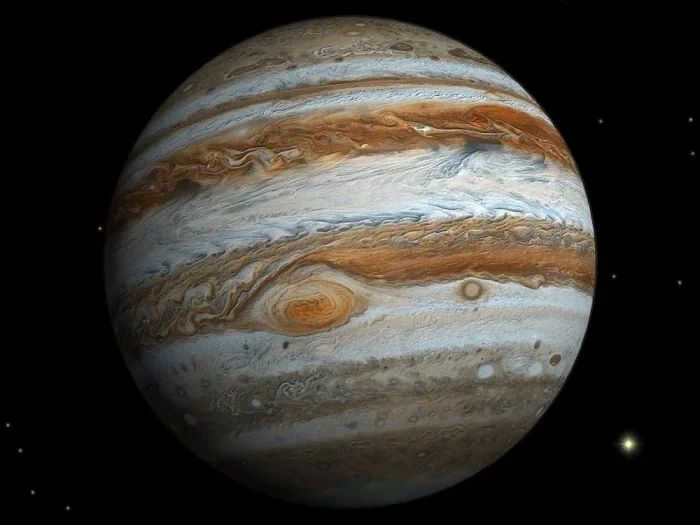
Jupiter, known as the giant of the solar system, is the largest planet in our celestial neighborhood. Its atmosphere, like that of the Sun, is primarily composed of hydrogen and helium. Additionally, Jupiter boasts a multitude of satellites orbiting around it, similar to a miniature model of our own solar system.
The distinctive feature of Jupiter’s surface is its vibrant stripes, which are the result of powerful winds reaching speeds of up to 640 kilometers per hour.

Saturn, the sixth planet in our solar system, possesses a unique characteristic – its density is actually lower than that of water (approximately 700 kilograms per cubic meter). In fact, if Saturn were placed in an immense ocean, it would effortlessly float upon its surface.

Uranus can be classified as an “ice giant.” This celestial body experiences extremely low temperatures, reaching as low as minus 224 degrees Celsius. What sets Uranus apart is its unusual rotation, as it spins “on its side.” Additionally, the planet has incredibly long seasons, with winter and summer lasting for forty-two years.

It is the final planet within the solar system.
Neptune possesses icy oceans comprised of water and ammonia. Triton stands as the largest moon of this massive planet.
Moons of planets within the solar system
Moons are celestial objects that orbit a planet along a specific trajectory.
For instance, the Earth’s moon is considered a satellite of the planet Earth.
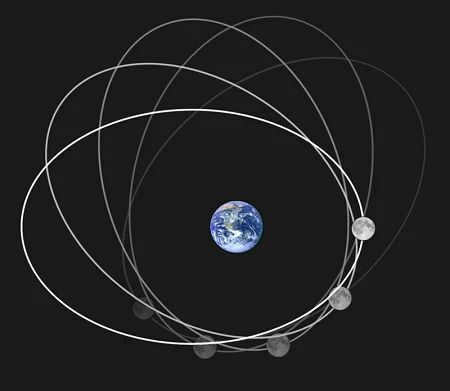
The phenomenon of the circular orbits of the planetary satellites can be seen in the case of celestial bodies such as the Moon and the Earth.
Furthermore, there exist man-made satellites that revolve around planets. These are known as spacecrafts that have been intentionally placed into orbit.

Observation of a planet from the International Space Station
Definition of astronomy
Astronomy is the scientific field that focuses on the study of our solar system and its planets. It has been a subject of interest for humans since ancient times, as they have always been curious about the celestial objects they observed in the sky.
- For example, early nomadic societies used the positions of stars to determine seasons, created calendars and journals, and observed the sunrise and sunset;
- Around two thousand years ago, ancient Chinese civilizations were able to predict solar and lunar eclipses;
- The development of astronomy as a separate scientific discipline began during the Renaissance period. Prior to this, it was closely associated with astrology.
- The world system was developed by the scientist Ptolemy during the Middle Ages;
- In 1666, astronomer I. Newton discovered and applied the law of universal gravitation and later proved the force that keeps the Moon in motion around the Earth;
- With the launch of the first satellite in 1957, a new era in the study of the solar system began. Great discoveries in astronomy were made during the Soviet era, and the first images of the planet Earth were captured.

The inaugural image of our planet
Groundbreaking breakthroughs in the field of astronomy:
Magnetospheric orbs
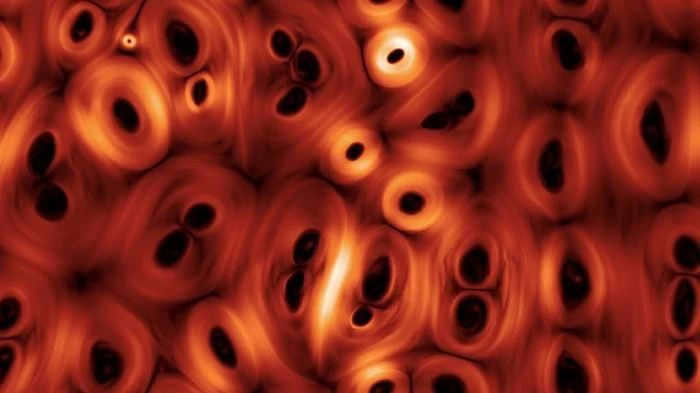
This is a foam-like magnetic “shield” that safeguards the solar system against a range of radiations originating from the galaxy.
An astronomical entity with a “tail”
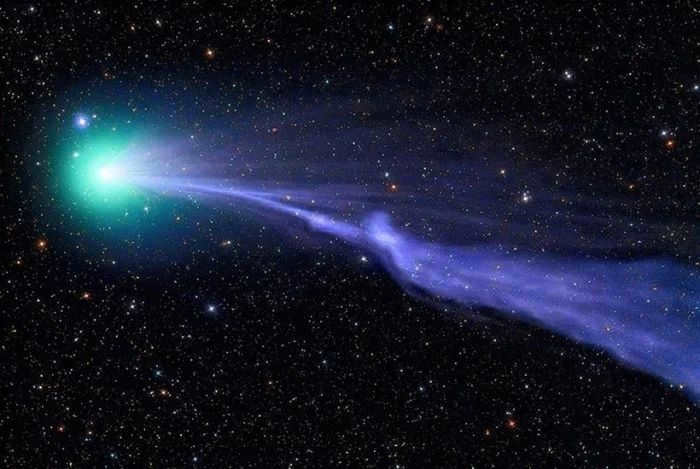
Previously, it was believed by scientists that stars did not possess a “tail” like comets. However, this hypothesis was proven false through the observation of the star Mira A.
Water on the Moon
The presence of water on the Moon has been confirmed, with ice formations discovered at the bottom of craters.
Indications of Water on Mars

Water streams have been detected on the surface of Mars by Mars rovers and specialized spacecraft. This recent scientific breakthrough in the field of astronomy has sparked numerous theories regarding the potential existence of life on the red planet.
Constellations are arrangements of stars that occupy specific regions in the celestial sphere and form recognizable patterns. Typically, these patterns are composed of the brightest stars visible to the naked eye, although some constellations can be challenging to identify and may appear shapeless and faint.
For instance, some of the most well-known constellations that numerous individuals are familiar with include the Big Dipper, the Little Dipper, Orion, and the Swan. The Big and Little Dippers, as well as Orion and the Swan, are easily identifiable in the night sky due to the arrangement of their brightest stars, which form dipper-like shapes. Orion resembles an hourglass with three stars located in its central region, while the Swan appears as a large cross.
The shapes of these constellations are purely imaginary, serving as aids to help people remember them and locate them in the sky. In reality, each individual star exists independently and has no actual connection to the others. Two stars within the same constellation, even if they appear close together in the sky, can actually be located at significantly different distances from us – one could be a dozen light years away while the other could be a thousand light years away.
Thus, the classification of stars into constellations is purely arbitrary, serving the purpose of simplifying navigation and cartography. Similarly, the water on our planet is conceptually divided into oceans, despite the fact that they collectively constitute a single World Ocean. However, in ancient times, individuals genuinely perceived human and animal shapes within the patterns of stars and bestowed them with names. Numerous of these designations have endured throughout history, and the outlines of the constellations delineate these particular figures.
Fascinating information about constellations
- Constellations have been recognized since ancient times – each civilization found something extraordinary in the groupings of stars and bestowed upon them a unique name. Currently, there are officially 88 constellations, and their definitive list was ratified in 1930. Of these, 48 were already known during the time of Ptolemy, who lived in the 2nd century AD.
- The names of constellations were assigned based on the shape that was observed among the stars. Typically, these shapes were representations of ancient Greek heroes from mythology or animals such as the Lion, Dragon, Hercules, Andromeda, Perseus, and many others. Some constellations were named after the appearance of objects if they possessed a distinctive form, such as the Northern Crown or the Southern Cross.
- There are only 58 constellations that have a bright star known as alpha, which is significant enough to have its own name. The remaining constellations have an alpha star that is so faint that it has not been assigned a name.
- Hydra is the largest constellation, covering a vast area of 1303 square degrees in the sky. On the other hand, the Southern Cross is the smallest constellation, occupying only 68 square degrees.
- The Big Dipper is the most well-known constellation, largely due to its distinctive shape formed by several bright stars. It is only slightly smaller than Hydra, spanning 1280 square degrees.
- Certain constellations offer a plethora of interesting objects to observe with the naked eye, binoculars, or an amateur telescope. They are home to star clusters, variable and double stars, galaxies, and nebulae. Meanwhile, there are some constellations that do not hold any remarkable features for amateur astronomers.
Maps showing the arrangement of stars and constellations
The expanse of the starry sky is vast, and to avoid getting disoriented, it is advisable to first acquaint oneself with the constellations. Numerous star charts and atlases have been created for this purpose. A printable version, suitable for observing with the naked eye or binoculars, is available for download here. Simply print it out and bring it along for outdoor use.
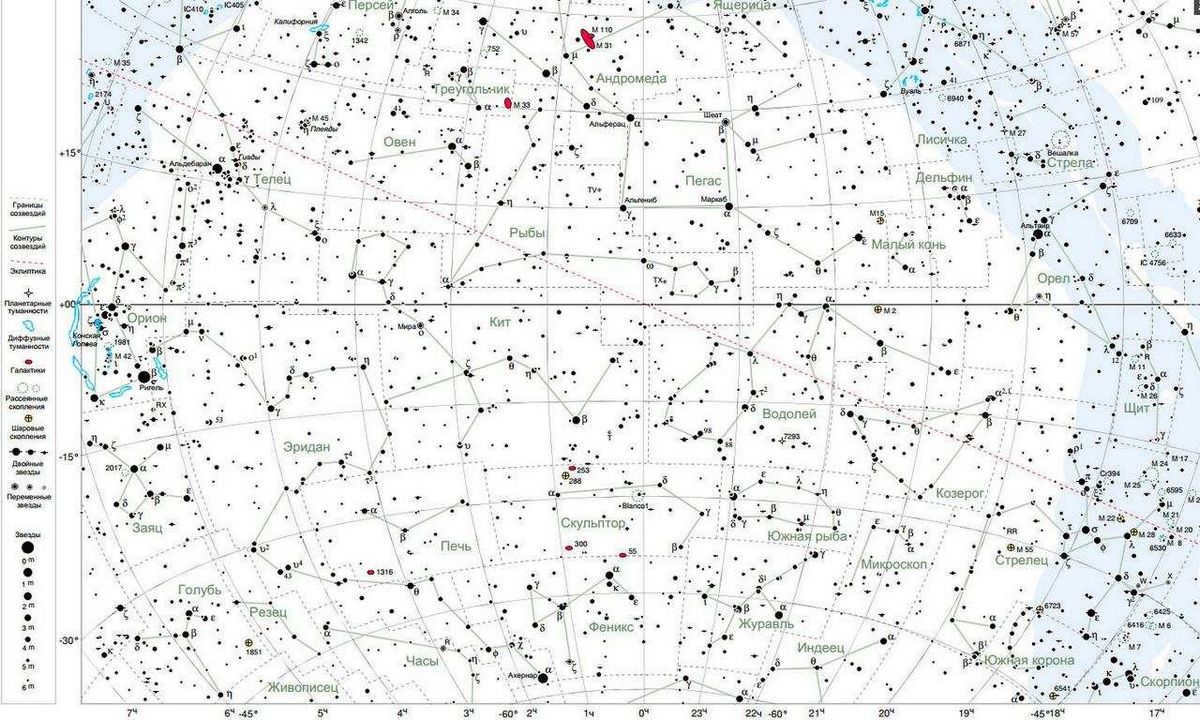

Stellarium, a virtual planetarium, is a very useful tool for observing constellations in the night sky. It is widely regarded as one of the most popular astronomy software programs available for Windows computers. This program provides a detailed view of the sky from a specific location at the current time or any other desired time. It not only allows users to locate constellations, but also provides information on the positions of the Moon, planets, and comets. Additionally, there is a version of Stellarium available for Android smartphones and tablets.
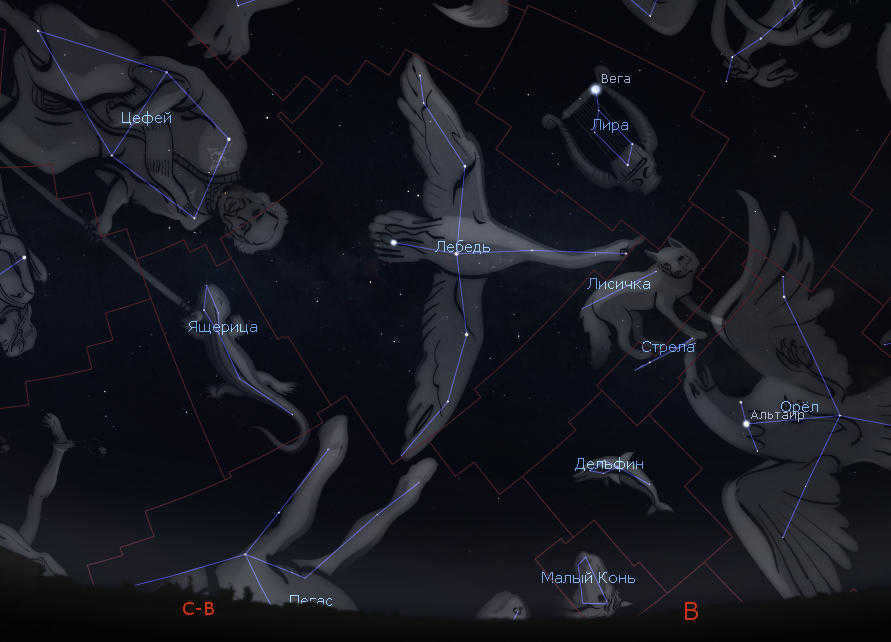
Constellations in the Stellarium software.
Distinguishing asterisms from constellations
Asterisms are distinct patterns in the sky that aid in locating various celestial objects. They are formed by imaginary lines connecting stars that are well-spaced apart. These stars can belong to the same or different constellations. In other words, an asterism can be a part of a constellation.
For instance, one of the most renowned asterisms is the Great Summer Triangle, which is composed of the prominent stars Vega, Deneb, and Altair – the alphas of the constellations Lyra, Cygnus, and Aquila. These three brightest stars in the summer sky actually create an almost isosceles triangle, which is highly visible.
One more well-known asterism is the Great Pail of the Ursa Major constellation. Indeed, it is just an asterism, as the constellation itself is much larger and the Pail is merely a part of it. However, this part stands out significantly and truly resembles a pail.
Orion’s Belt, consisting of three stars arranged in a line, is also a widely recognized asterism.
In reality, there are numerous asterisms in the celestial sphere. All of them create simple shapes that are easy to remember. They facilitate the process of locating various objects or constellations in the sky. For instance, the Summer Triangle can be identified at a glance, and its vertices are the main stars of three constellations simultaneously. Another example is that Polaris can be easily found by following the line formed by the handle of the Big Dipper.
An asterism can either be a part of a single constellation or be made up of stars from multiple constellations. The configurations of constellations are also based on asterisms.
Winter, Spring, Summer, and Fall Skies Constellations
Throughout the year, as the Earth completes its revolution around the sun, we are able to observe different constellations in the night sky. Naturally, if we had night time continuously, we would be able to see all the constellations during the day as well. However, we also have daytime, so the night sky gradually changes.
Depending on the time of year when a constellation is most visible, it can be categorized as a winter, spring, summer, or fall constellation. For instance, Orion is a classic winter constellation, as it rises in the east during late fall, reaches its highest point in mid-winter, and sets in the west during the spring.
The constellations situated at the poles are referred to as polar constellations and can be observed throughout the year. Only their elevation above the horizon varies.
What is the number of constellations in the sky?
Officially, a list of 88 constellations was established by the International Astronomical Union in 1930, with 13 of them belonging to the zodiacal constellations. This is the current list that we adhere to. The boundaries of each constellation were also defined in their modern form by the Belgian astronomer Eugene Depport. There are no plans to make any further changes to this list.
However, it was not always so rigid. In the past, each culture had its own mythology and legends, resulting in different constellations. Astronomers have also made attempts to establish their own regulations, dividing some constellations and adding others.
Back in 1799, Jerome de Lalande, a renowned French astronomer, made the decision to bring to life the constellation of Cat. This unique constellation was crafted out of his love for felines, and as a token of appreciation for his years of hard work, he wanted to immortalize a cat in the sky. Amazingly, the constellation of Cat was indeed created near Hydra and existed for quite some time, even being featured in atlases of that era. However, in 1930, it was eventually removed and is no longer visible in the night sky.
Stories like this are not uncommon. In fact, Edmond Halley himself attempted to establish the constellation of Charles’ Oak, as a tribute to the tree where King Charles II sought refuge after his father’s army was defeated by Oliver Cromwell. This constellation also came into existence for a period of time, until the Argo Ship was dismantled, causing the Oak to fall within a different region of the sky.
Complete list of star groups
Here is a contemporary compilation of all 88 star groups that currently exist in the celestial sky. By clicking on the desired column heading, the table can be sorted.
Star groups in the North and South
Due to the Earth’s spherical shape and its slight tilt, certain star groups can be observed in the northern hemisphere while others can be seen in the southern hemisphere. Some star groups, situated in the celestial equator region, can rise above the horizon in both hemispheres at specific times of the year.
The majority of star groups visible in the mid-latitudes of the northern hemisphere are not visible in the southern hemisphere, and are referred to as northern star groups. Conversely, numerous southern star groups are never visible in the northern hemisphere. This is particularly true for the polar star groups.
That is the reason why Russian inhabitants will never have the opportunity to observe the Southern Cross, Indian, Microscope, and other constellations located in the southern part of the sky – to do so, one must travel to the regions located south of the equator. Similarly, residents of Australia will never be able to see Cassiopeia, Lyra, Swan, and other constellations that are positioned in the northern part of the sky from their homes.
Out of the total of 88 constellations, only 36 of them are classified as northern constellations, while the remaining 52 are grouped as southern constellations. However, it is worth mentioning that some constellations can be observed in both hemispheres, although they do not rise to a significant height above the horizon. For example, the constellation Canis Major, which includes the bright star Sirius, is part of the southern constellations, but during the winter season, it is clearly visible in the middle latitudes of the northern hemisphere. Other constellations such as Hydra, Unicorn, and Whale can also be partially or fully visible.
Movement of celestial entities along constellations
When observing the Moon’s position over the course of a month, one will observe a gradual eastward shift, leading it to occupy different constellations. The Moon undergoes a daily displacement of 13 degrees, completing a full circle and traversing 12 constellations within a span of 27 days.
Similarly, the Sun also follows a similar pattern of movement, albeit on a larger scale. Over the course of a year, the Sun completes a full circle, shifting by 1 degree each day.
Zodiac Constellations
The constellations that the Moon and the Sun pass through are known as zodiac constellations. Each season, the Sun passes through three zodiac constellations:
- Spring – Pisces, Capricorn, Virgo.
- Summer – Libra, Sagittarius, Scorpio.
- Fall – Leo, Aquarius, Taurus.
- Winter – Gemini, Cancer, Aries.
The constellations that the Sun is currently in become visible after six months, when they appear in the evening. During daylight, they are not visible, but after six months, they are on the opposite side of the Sun and can be seen at night.
The zodiac constellations in astrology are ascribed with special attributes, which, naturally, do not actually exist. Similarly, the planets only traverse through the zodiac constellations, forming the foundation of various horoscopes.
Constellation history
Most of the constellations and their prominent stars derive their names from ancient Rome, Greece, and the East. There are a total of 50 such constellations. The remaining 38 have modern appellations that astronomers have coined in recent centuries.
When Eudoxus of Cnidus introduced astronomy in Babylon during the fourth century, he cataloged 48 constellations, which were later reaffirmed by Ptolemy. Among these, 30 constellations had been recognized since ancient times, with some dating back to the Bronze Age.
The Greek system as we know it today was developed based on the Babylonian astronomical system. Many of the names that we use for celestial bodies and astronomical concepts can be traced back to this ancient era.

Bayer introduced 11 constellations that are still present in our skies today – the Fly, the Toucan, the Goldfish, the Phoenix, the Indian. He also assigned Greek letters to 1564 stars based on their brightness – the brightest star was labeled as alpha, followed by beta, and so on. These designations are still used in astronomy today.
French astronomer Nicolas Louis de Lacaille also contributed to the constellation list by adding some that still exist today – Octanthus, Pump, Table Mountain, Furnace, Painter. He published his catalog in 1756.
Therefore, the names of the constellations have largely been inherited from ancient times, with the addition of newer ones, particularly in the southern hemisphere. Throughout history, the boundaries of constellations have also undergone numerous changes until they reached their modern form.
Observation
Engaging in the observation and study of constellations is an incredibly intriguing endeavor. Each day, these clusters of stars shift ever so slightly towards the west, while new ones emerge in the east. Over the span of a year, one has the opportunity to witness all the constellations that are visible within a specific hemisphere.
Indeed, a knowledge of constellations is essential for anyone interested in the field of astronomy. It is as fundamental as understanding the alphabet for reading or comprehending numbers for mathematics. By familiarizing oneself with the constellations, it becomes effortless to locate any object of interest. Moreover, it proves advantageous to be aware of the brightest stars that these constellations encompass.
In order to study constellations, it is necessary to utilize maps. These maps can be obtained or alternatively, one can make use of the exceptional free program known as Stellarium, which is compatible with both computers and smartphones.
Constellations essentially serve as divisions of the celestial sphere, grouping stars together.
Ancient people were the ones who came up with the concept of constellations. These constellations were used for navigation even in those ancient times. Back then, constellations referred to the patterns formed by the stars in the sky. These patterns were often named after and resembled various animals. Naturally, many myths and legends were tied to these constellations.
While the study of constellations dates back to ancient times, it wasn’t until the 16th century that the most detailed descriptions of them started to emerge.
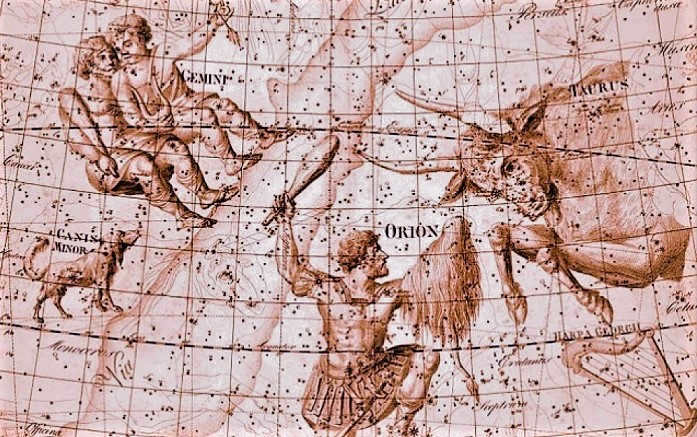
An ancient map depicting the celestial sphere
When it comes to the question of why scientists named different parts of the night sky as constellations, the answer is quite simple.
Constellations in the night sky serve as a system of star groupings. This division of the celestial plane into distinct sections allows for a more practical approach to studying the cosmos. In other words, the division of space into separate sections is necessary for the convenience of exploring the vastness of the universe.
Types of constellations
You may be wondering: what types of constellations are there? The variety is quite extensive.
Firstly, there are the well-known zodiac constellations. These are groups of stars that the Sun passes through over the course of the year. Interestingly, there are actually more than the commonly believed 12 zodiac constellations. In reality, there is a 13th zodiac constellation known as the Serpens.
Secondly, we have the equatorial constellations. These are constellations that lie along the celestial equator.
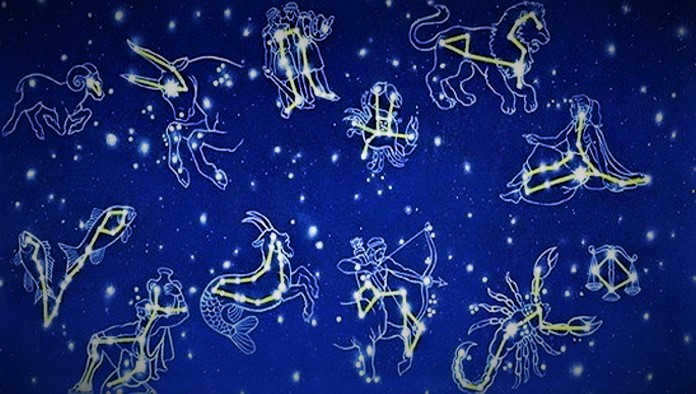
Currently, there are 88 officially recognized and accepted stellar regions, dividing the celestial space into distinct areas. These regions are defined by boundaries and interestingly, almost all of them contain exceptionally bright stars. They are denoted by Greek letters such as Alpha, Beta, Gamma, and others. These designations are used when categorizing constellations based on their composition.
Thanks to these prominent stars, it is convenient to locate specific constellations and the objects within them.
Furthermore, there are established stars that exist within other regions, known as asterisms.

The constellation Swan contains an asterism known as the Northern Cross. Different constellations are more prominent in the sky at different times of the year, and some can only be observed from specific locations on Earth. This is why star systems are often categorized into northern and southern hemisphere constellations. Additionally, there are groups of stars associated with each season – summer, spring, fall, and winter – depending on when they are most visible to observers.
Civilizations rise and fall, but the stars endure and will continue to shine eternally.
Galactic Express 999
The Marvels of the Universe: Constellations
So, what exactly are constellations? They represent significant regions within the vast expanse of the star-studded sky.
Delving into the study of these celestial formations is not only crucial for navigation and unraveling the mysteries of the universe, but it also unveils a world of unparalleled uniqueness and fascination. Rest assured, observing constellations guarantees an absence of monotony.
Furthermore, scientists have made the remarkable discovery that the positions of stars evolve over time. Admittedly, this process occurs at an incredibly leisurely pace, but it undeniably adds an element of excitement to the equation.

Everyone is familiar with the numerous constellations that can be seen in the starry sky. However, have you ever wondered what exactly is a constellation? Although we often use this term without thinking twice, it may not be as clear-cut as we assume. If you were to ask someone who is not well-versed in astronomy to define a constellation, chances are they would struggle to provide a coherent response. Most individuals would simply say:
The initial definition is quite ambiguous, leaving us uncertain about the specific groups being referred to. Are all groups considered constellations? Or are there certain principles that dictate how stars are grouped together?
The second definition is more specific, but it still needs clarification because, for instance, the well-known star formation known as the Big Dipper is not considered a constellation. Conversely, attempting to identify any recognizable pattern within the constellation Lynx can prove challenging!
What exactly is a constellation in the field of astronomy?
Astronomy is an age-old discipline that, like all sciences, continues to progress. As a result, concepts, including those surrounding constellations, also evolve.
Back in the day, constellations were known as unique groupings of stars that were easily memorable.
What was the purpose of this? It was to aid in spatial and temporal navigation.
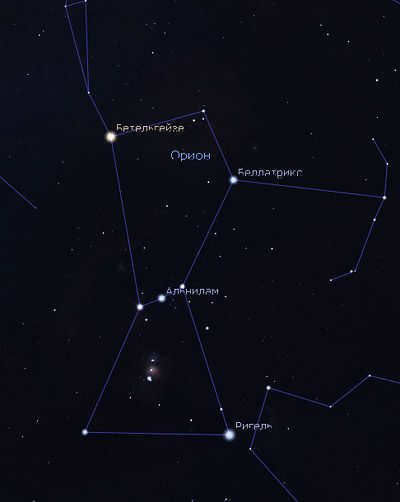
The constellation Orion consists of seven of the brightest stars that form a shape resembling an hourglass. While many people refer to this shape as a constellation, it is actually an asterism. This formation can be seen in the image above, which was captured by Stellarium.
In ancient times, the sky served as both a clock and a compass for our ancestors. Farmers relied on the sky to determine the optimal times for sowing and reaping crops, while nomadic tribes used it to navigate their surroundings. The Sun, Moon, and stars all played crucial roles in these celestial observations.
The unique characteristic of stars is their unchanging position in the sky over extended periods of time, sometimes lasting for hundreds or even thousands of years. It is almost as if they are deliberately fixed to the celestial sphere, as astronomers would describe it. As a result, stars serve as an ideal backdrop against which the movements of the moon and sun can be observed and used to create calendars or determine the time.
However, it can be challenging to differentiate between individual stars. To address this, humans started grouping them together into constellations.
The constellations that have been around the longest have existed for at least 5000 years. These include the constellations of the Zodiac and a few constellations that can be seen near the polar constellations. The ancient Greeks, around 2 to 2.5 thousand years ago, identified a total of 48 constellations in the night sky. Almost all of these ancient constellations have a distinct pattern and feature at least one prominent star.
Nowadays, astronomers refer to bright, easily remembered groups of stars as asterisms.
For instance, the Big Dipper, which was mentioned earlier, is not considered a constellation but rather an asterism. The Big Bucket is the most prominent part of the Big Dipper constellation, although it represents only a small portion of it. Similarly, the hunter-Orion figure, comprised of seven bright stars, is also classified as an asterism.
However, in the past, this was not the case. Historically, the constellations did not have clearly defined boundaries. The spaces outside of the prominent patterns were filled with vacant patches of sky where neglected stars resided. Consequently, astronomers would divide and subdivide these areas as they deemed suitable, resulting in the addition of numerous constellations to the night sky.
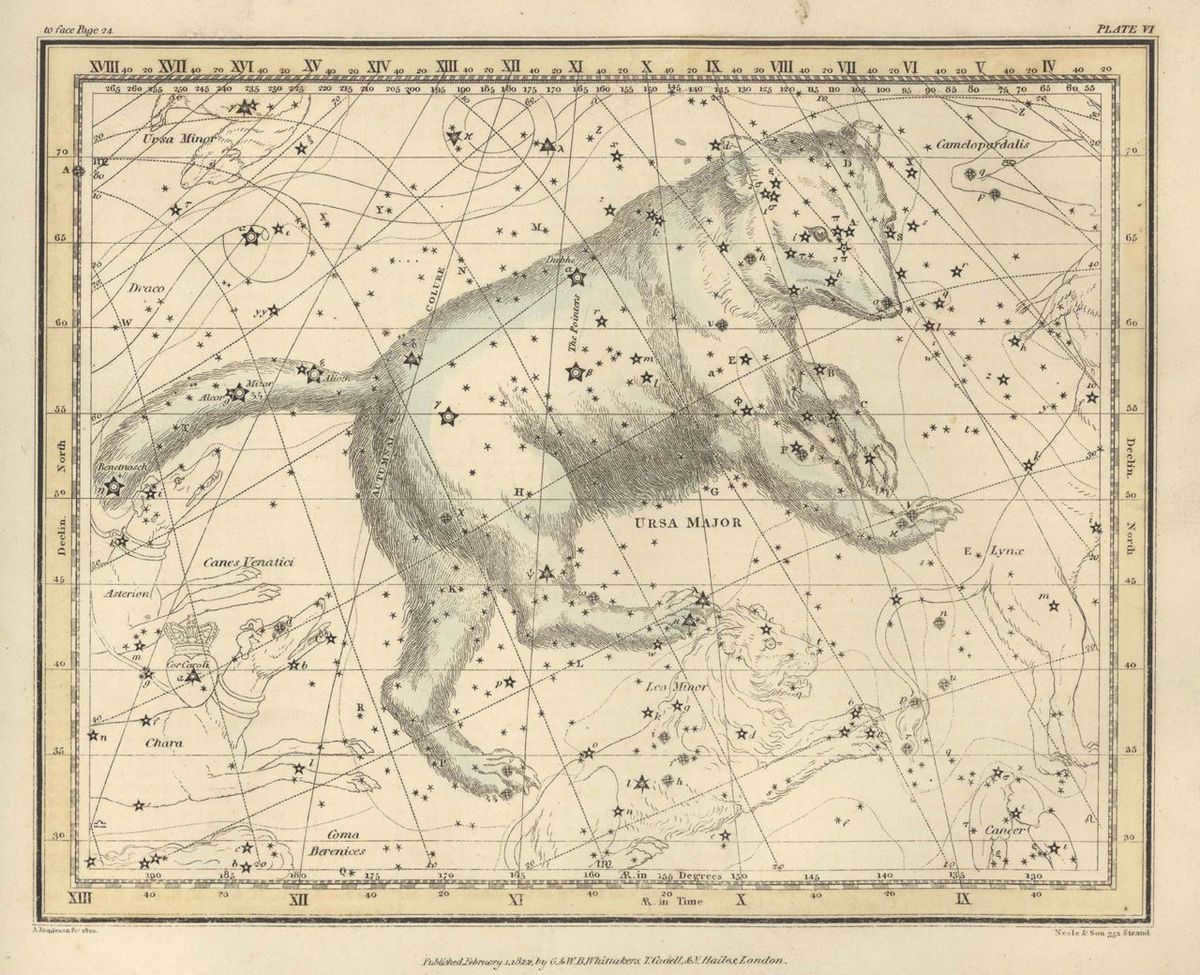

The Big Dipper constellation in Alexander Jamieson’s atlas (1822) has arbitrary boundaries drawn by the author. The boundaries are marked with a dotted line. (Click on image to enlarge.) Source: Ian Ridpath
In the first half of the 20th century, this practice was discontinued. During the general assembly of the International Astronomical Union in Rome in 1922, it was decided to divide the entire sky (north and south) into regions with clearly defined boundaries that would not be changed.
This is how the modern constellations were established.
So, what is now referred to as a constellation?
- Expressive and easily remembered groups of stars, known as asterisms, are what constellations are referred to as on a daily basis. This tradition has its roots in ancient times.
- From the perspective of modern astronomers, constellations are defined as specific areas of the sky with precise boundaries. There are no areas of the sky that are not included in some constellation, even the darkest and starless regions belong to one constellation or another.
The modern representation of the Big Dipper constellation has clearly defined boundaries. The Big Dipper asterism is a part of the Big Dipper constellation. Source: IAU
What do constellations not represent?
Constellations do not represent asterisms
This is a crucial point, so let me reiterate. Asterisms are what constellations used to be in ancient times – memorable groups of stars that were associated with everyday objects, animals, or mythical characters. Nowadays, an asterism can be a part of a constellation (such as the Big Ladle) or consist of stars from different constellations (like the Summer Triangle). A constellation, on the other hand, is a distinct section of the sky with well-defined boundaries. By the way, the boundaries of all constellations are determined solely by lines of declination or right ascension.
Constellations are not physical objects, but rather directions in the sky
It may sound amusing, but constellations are not tangible entities. Instead, they serve as guides to navigate the vastness of the celestial sphere. This means that comparing the size of a constellation to a galaxy, for example, is a nonsensical question. The celestial objects within a constellation, such as stars, nebulae, and galaxies, are actually located at varying distances from Earth. Some are relatively close, just a few light years away, while others are much more distant, hundreds or even thousands of times farther. However, due to their immense distances, these variations are not perceivable to the naked eye, making it appear as though they are all at the same distance on the celestial sphere. In reality, we, as observers on Earth, are situated at the center of this celestial sphere, gazing out into the vastness of the starry sky. Hence, constellations serve as navigational markers on our cosmic map.
Humans are credited with the invention of constellations
What is the definition of constellations?
Constellations are formations of stars arranged in specific patterns. In ancient times, these arrangements were associated with mythical creatures or objects, and were given names that are still used by astronomers today.
What do asterisms represent?
Besides constellations, there are also asterisms. These concepts are quite similar in meaning, but they do have some differences. Asterisms are groups of stars that are included in a specific constellation and create a recognizable shape that can be easily seen in the night sky, even without the use of a telescope. There is no official list of asterisms, as they are compiled by amateur astronomers. An interesting fact is that the most well-known asterism is the Bucket, which is a part of the Big Dipper constellation. Its shape, consisting of seven stars, is easily identifiable in the darkness. In the past, Russian astronomers included not only groups of stars arranged in a particular shape, but also their clusters that were easily recognizable through amateur telescopes. It can be said that asterisms were created to simplify the study of the starry sky map for those who did not have advanced space exploration technology. With the help of asterisms, astronomers can easily determine the position of major celestial objects and proceed with further observations. Currently, there are 28 major asterisms, 23 of which are part of various constellations. The remaining five are large star clusters.
What is the origin of the names of the constellations?
- The name Andromeda comes from the daughter of Cassiopeia and Cepheus, who was given as a sacrifice to Cetus;
- Aquarius – its name is directly connected to King Tros, who carried a cup around Olympus;
- Canis Major – named after a mythical creature that haunts the Hare constellation;
- Bird of Paradise – resembling a legless bird, this name is based on the belief of Westerners that these creatures did not have legs;
- Aries – a large ram with wings and a golden fleece, sent to help Phrixus, whom his father mistakenly wanted to sacrifice to the gods in order to save his people from famine;
- Cancer – named after the crab Karkinos, who was sent to hinder Heracles from fighting the Hydra.
- Keel – part of the ship on which Jason and the Argonauts sailed;
- Cassiopeia – the wife of Cepheus, who enchanted the nymphs with her beauty.
Some constellations are in close proximity to each other, which creates a connection between them. For instance, it is believed that the Hound Dogs follow the Big Dipper.
The human eye can observe a multitude of stars in the night sky. There are so many that counting them seems impossible, but the naked eye can see approximately three thousand stars. In total, there are around six thousand stars visible.
It is likely that in the early days of civilization, individuals attempted to comprehend the vast array of stars and remember their positions by mentally grouping them into specific shapes. Many centuries ago, humans would gaze up at the sky, tally the number of stars, and mentally connect them to form various shapes known as constellations. These constellations were often named after characters from ancient myths and legends, as well as animals and objects.
Each culture had its own unique myths and legends surrounding constellations, resulting in different names and varying quantities of constellations. The actual drawings of the constellations rarely matched the named figure precisely, but they served as a helpful tool for navigating the sky. Even young boys in ancient Chaldea or Sumer were more familiar with the night sky than any of us could ever be.
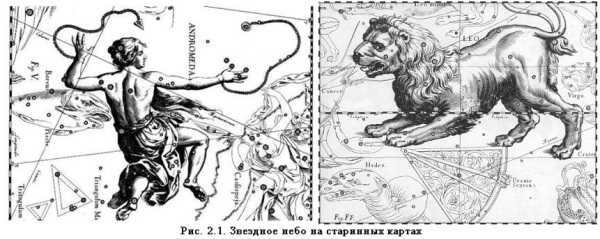
In the field of astronomy, constellations refer to specific regions of the sky that are defined by distinct boundaries. Each constellation is characterized by a unique group of stars that are located within its designated area. These constellations appear as clusters of stars when projected onto the celestial sphere.
The oldest known constellations are the zodiacal constellations, which form a belt along the path of the Sun, Moon, and planets. Taurus, for example, was recognized over 4000 years ago because it aligned with the vernal equinox during that time period.
Throughout history, different cultures and eras have employed various methods for dividing the stars into constellations.
- In the 4th century BC, there was a record of 809 stars included in 122 constellations.
- In the 18th century, in Mongolia, there were 237 constellations.
- In the 2nd century, Ptolemy (“Almagesta”) described 48 constellations.
- In the 15th-16th century, during the period of great sea voyages, 48 constellations of the southern sky were described.
- The Russian star atlas of Cornelius Reissig published in 1829 contained 102 constellations.
During the 17th-19th centuries, many star maps (atlases) included the names of constellations and drawings of figures. However, it was Jan Hevelius’ star atlas, published in 1690, that truly stood out. It not only provided the exact locations of stars and introduced equatorial coordinates for the first time, but also featured beautiful drawings.
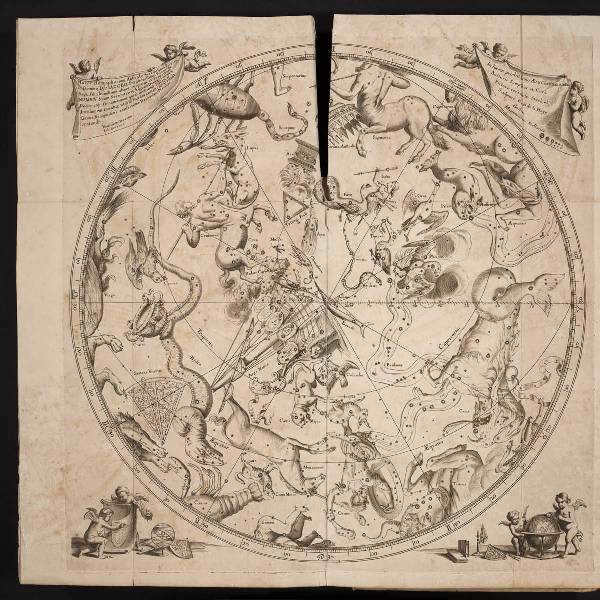
Constellations of the Southern Hemisphere depicted in Hevelius Jan’s Uranographia from 1690.
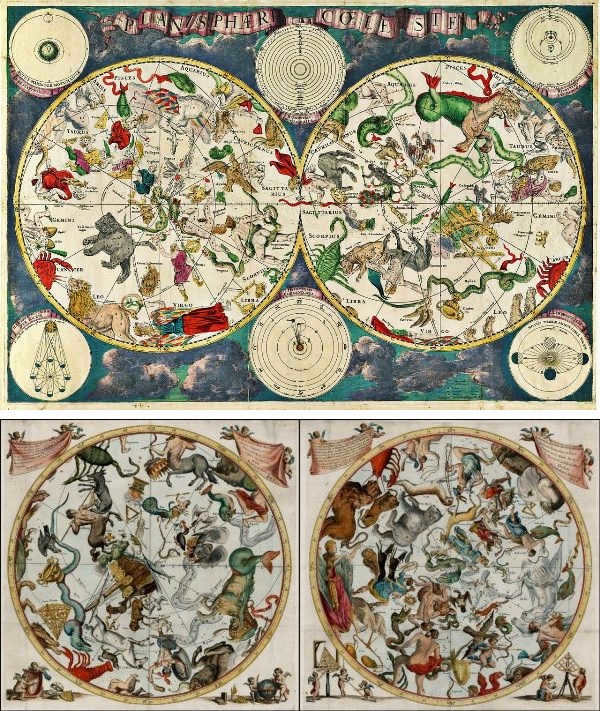
Starry sky atlases from the 17th century
The confusion surrounding constellations was resolved in 1922 when the International Astronomical Union divided the entire sky into 88 constellations, and the boundaries were officially established in 1928.
Out of all 88 constellations, one of the largest and most well-known is the Big Dipper.
When observing the night sky, it becomes apparent that stars vary in brightness, or, as astronomers would say, in brilliance.
The apparent brightness of a star is known as stellar magnitude. Stellar magnitude does not indicate the size of a star, but rather its brilliance. The higher the stellar magnitude, the fainter the star appears.
When scientists developed instruments to measure the amount of light emitted by stars, they discovered that a first magnitude star emits 2.5 times more light than a second magnitude star, a second magnitude star emits 2.5 times more light than a third magnitude star, and so on. Some stars, known as zero magnitude stars, emit 2.5 times more light than first magnitude stars. The brightest star in the sky, Sirius (α of the Big Dog), has a negative stellar magnitude of -1.5, while the Sun has a stellar magnitude of -26.8.
The most remarkable objects among the fainter stars were assigned their own names, which originated from Arabic and Greek (there are more than 300 stars with names).
In 1603, Johann Bayer (1572-1625) from Germany published a catalog of all visible stars and introduced a system of naming them using the letters of the Greek alphabet in descending order of brightness. The brightest star is labeled as α, followed by β, γ, δ, ε, and so on.
Within each constellation, stars are designated using letters of the Greek alphabet in decreasing order of their brightness. The brightest star in a constellation is labeled as α, the second brightest as β, and so on.
Stars differ not only in their brightness but also in their color.
They can have different colors such as white, yellow, and red. The redder the star, the cooler it is. Our sun is a yellow star.
Thanks to the invention of the telescope, scientists gained the ability to observe stars that emit much less light than sixth magnitude stars. As telescopes have become more advanced, the scale of stellar magnitudes has expanded, allowing for the detection of fainter and fainter objects. The Hubble Space Telescope, for instance, has revolutionized our ability to capture images of incredibly dim celestial bodies, reaching up to the thirtieth magnitude.
The night sky is home to trillions of stars, some of which form constellations – specific regions in space that aid in orienting ourselves across the celestial sphere. Throughout history, people have recognized that these points of light align in particular patterns, sometimes even resembling recognizable figures. Over time, astronomers have extensively studied many of these constellations that lie within visible range of our solar system, making it easier to navigate the vastness of space.
What is the definition of constellations?
Constellations are groupings of stars that form specific shapes or patterns in the sky. In the past, these arrangements were often likened to mythological creatures or recognizable objects, which is how they acquired their names. Astronomers continue to use these names to identify and study constellations today.
What do we mean by asterisms?
Aside from constellations, there are also asterisms. While the two concepts are similar, there are some key differences. Asterisms are clusters of stars that belong to a specific constellation and create a recognizable shape that can be easily seen in the night sky, even without the use of a telescope. Unlike constellations, there is no official list of asterisms as they are compiled by amateur astronomers.
Fun fact: one of the most well-known asterisms is the Bucket, which is part of the Big Dipper constellation. Its shape, made up of seven stars, is easily identifiable in the darkness.
In the past, Russian astronomers considered not only groups of stars arranged in a specific shape as asterisms, but also their clusters, which could be easily recognized using amateur telescopes.
It can be said that asterisms emerged as a way to simplify the examination of the starry sky map for individuals lacking advanced space exploration technology. By utilizing asterisms, astronomers are able to easily identify the positions of significant celestial objects and subsequently engage in further observation.
Presently, there exist 28 prominent asterisms, with 23 of them being encompassed within various constellations. The remaining five are expansive assemblages of stars.
What distinguishes asterisms from constellations?
There is a slight distinction between asterisms and constellations, which can be confusing for those unfamiliar with the intricacies of studying the cosmos. To clearly define the terms, it is helpful to understand the meaning of each individually.
A constellation refers to a collection of stars that are situated within a specific region. This includes not only the stars that form a pattern, but also others that are located in close proximity. Ancient observers noticed that certain stars in the sky could be grouped together, giving rise to the first constellations.
Interesting fact: The first constellations were documented by the Greek poet Aratus in 270 BC.
During the 16th and 18th centuries, when the first telescopes were invented, there was a growing interest in the universe. Many astronomers dedicated their time to studying the night sky and searching for new constellations. In this era, the clusters representing the Zodiac signs and star formations such as Orion’s belt were added to Ptolemy’s original discoveries. Astronomers from various parts of the world were constantly making new findings. However, it soon became evident that these newly found constellations were either already known or part of existing ones. There were actually quite a few of the latter. As a result, the concept of “asterism” emerged.
Asterisms form an integral part of a constellation, serving as its foundation and comprised of the most notable stars. These asterisms are easily visible through an amateur telescope. Given the limited availability of professional equipment in earlier times, astronomers had to content themselves with marveling at the asterisms, while the dimmer stars of the constellations remained concealed from view.
What is the origin of constellation names?
Constellations have their own unique names, each with a specific meaning. When Ptolemy compiled the first list of star clusters, he understood the importance of giving them memorable and captivating names. Drawing inspiration from the rich mythology of ancient Greece, he assigned names that were associated with this culture. Ptolemy quickly noticed similarities between the shapes of the constellations and significant animals and gods, resulting in the creation of constellations like Andromeda, Eagle, and Aquarius.
Interesting fact: The constellation Capricorn, discovered by Ptolemy, is named after the god Pan. However, it was also known as Almathea in ancient times, in honor of the goat that nursed Zeus as a baby.
In the 18th century, during the era of advancements in astronomy, scientists began to acknowledge and pay tribute to the tools that allowed them to explore the vastness of the night sky. One such example is Nicolas Louis de Lacaille, who included the Naugolnik, the Circulus, and the Telescope in the constellation catalog. It is interesting to note that the star patterns of these constellations do indeed resemble the shapes of these instruments.
The origins of some constellation names:
- Andromeda is named after the daughter of Cassiopeia and Cepheus, who was sacrificed to Cetus;
- Aquarius – its name has a direct connection to King Tros, who carried a cup around Olympus;
- Canis Major – named after a mythical creature that is said to haunt the constellation Lepus;
- Paradise Bird – its shape resembles a legless bird, reflecting the belief of Westerners that such creatures lack legs;
- Aries – a large ram with wings and a golden fleece, was dispatched to aid Phrixus, who his father mistakenly wanted to sacrifice to the gods in order to spare his people from famine;
- Cancer – named after the constellation in honor of the crab Karkinos, was sent to hinder Heracles from battling the Hydra;
- Keel – a part of the ship on which Jason and the Argonauts embarked;
- Cassiopeia – the wife of Cepheus, who enchanted the nymphs with her beauty.
Some constellations are in close proximity to each other, leading to some connection between them. For instance, it is believed that Canis Major and Canis Minor give chase to Ursa Major.
Constellations – divisions of the celestial sphere used for easy orientation in the night sky, according to modern astronomy. In ancient times, constellations were known as recognizable shapes formed by bright stars.
A Short Overview
In three-dimensional space, the stars we observe in close proximity on the celestial sphere can actually be quite distant from each other. Throughout history, people have perceived patterns and arrangements among the stars, classifying them into constellations based on these observations.
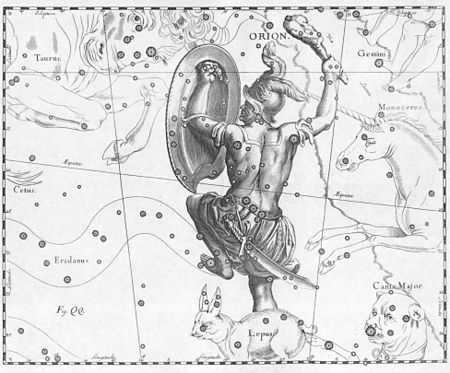
The list of 88 constellations, which divide the starry sky, was officially approved in 1922 in Rome during the I General Assembly of the International Astronomical Union. In 1928, clear and unambiguous boundaries were established between these constellations, based on the equatorial coordinate system at the epoch of 1875.0. Over the course of five years, these boundaries were refined, and in 1935, they were ultimately approved and have remained unchanged since then. However, it is important to note that the boundaries of the constellations have shifted due to the precession of the Earth’s axis. Therefore, star charts made for epochs other than 1875.0, including all modern charts, no longer align with the circles of direct ascension and declination.
List of celestial formations
The International Astronomical Union has officially acknowledged a total of 88 celestial formations. The table additionally provides the Latin names in the nominative and genitive [1] cases, official abbreviations, area in square degrees, and the count of stars with a brightness greater than 6.0 m . The inclusion of sorting by any parameter is intended to enhance user convenience.
Amidst different cultures
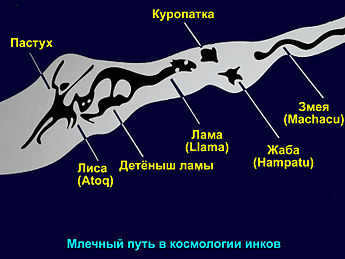
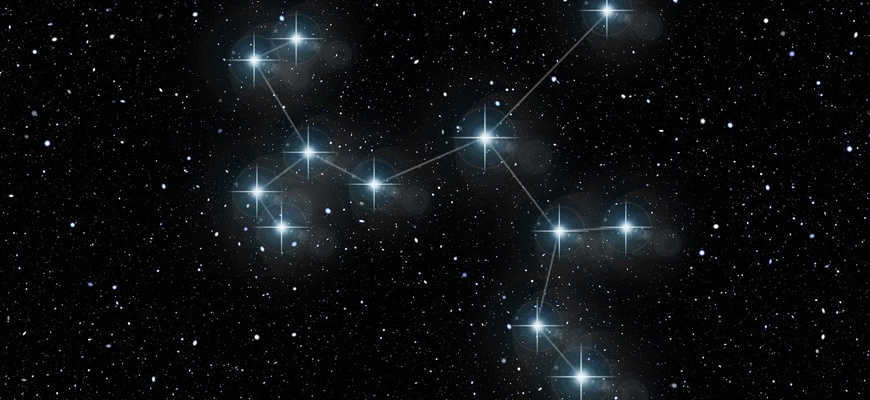
A breathtaking view of the night sky filled with shining stars is undeniably a captivating sight for hopeless romantics and a helpful guide for adventurous travelers. In the field of astronomy, scientists have successfully identified and categorized a total of 88 known star clusters, commonly referred to as constellations. This raises the intriguing question of what exactly constitutes a constellation.
The Fundamental Definition
At its core, a constellation can be defined as a designated area on the celestial canvas, where a group of stars are visually connected to form a specific shape or pattern. While these stars may be scattered across vast distances in space, when observed from our planet, they appear to align in a seemingly coherent line. Often, constellations are named after mythical creatures or legendary heroes, adding a touch of mystique to the night sky. The boundaries of each constellation are determined by galactic parallels and declination circles, providing structure and organization to the vast expanse of stars.
In the second century B.C., the celestial sphere was initially partitioned into delineations. It was during this time that rough drafts of the initial astronomical charts emerged. In the early 1800s, portions of the nocturnal expanse started to acquire identifiable outlines. The designations mirrored the cultural and mythological beliefs of that era. Distinct outlines could be observed during the winter and summer seasons. Occasionally, a single star could be associated with two constellations simultaneously.
Ancient and Modern Star Patterns
During the Bronze Age, certain celestial alignments were categorized into specific shapes. The ancient Sumerians assigned names to many of these alignments, which are now included in the zodiacal circle. The zodiac represents the area of the sky that the Moon, Sun, and other planets traverse. Currently, astronomers have identified thirteen star clusters that intersect with the annual path of the Sun.
In the early years of the 20th century, the definition of the zodiac was not clear and well-defined. Every country had its own classification. In order to establish official names, the International Astronomical Union (IAU) divided the celestial sphere into 88 recognized sections and figures in 1922. Presently, a constellation is a collection of celestial entities that possess an official designation. The most famous constellations include Ursa Major and Ursa Minor, as well as the Southern Cross. Each of these constellations can only be observed in a specific region of the sky. They remain relatively stationary and easily distinguishable.

The stars in the sky have always fascinated humanity. Since ancient times, people have grouped them together, forming constellations. Back then, little was known about the true nature of these celestial bodies, so humans assigned them patterns that resembled various animals or objects. Over time, these patterns evolved into legends and myths, giving the stars and constellations a deeper meaning.
Starry Sky Maps

Currently, there are a total of 88 constellations in existence. Among them, there are many notable ones such as Orion, Cassiopeia, and the Bears. These constellations contain a plethora of fascinating objects that can be observed not only by professional astronomers and amateurs, but also by ordinary individuals. In this section, we will provide detailed information about the most captivating objects found within these constellations. Additionally, we will include their precise locations, along with a plethora of captivating photos and entertaining video recordings.
| Spring | March – April – May |
| Summer | June – July – August |
| Autumn | September – October – November |
| Winter | December – January – February |
Alphabetical List of Sky Constellations
| Andromeda | Andromeda | And | 722 | 100 |
| Gemini | Gemini | Gem | 514 | 70 |
| Big Dipper | Ursa Major | UMa | 1280 | 125 |
| Big Dog | Canis Major | CMa | 380 | 80 |
| Libra | Libra | Lib | 538 | 50 |
| Aquarius | Aquarius | Aqr | 980 | 90 |
| Charioteer | Auriga | Aur | 657 | 90 |
| Wolf | Lupus | Lup | 334 | 70 |
| Wolf | Bootes | Boo | 907 | 90 |
| Veronica’s Hair | Coma Berenices | Com | 386 | 50 |
| Raven | Corvus | Crv | 184 | 15 |
| Hercules | Hercules | Her | 1225 | 140 |
| Hydra | Hydra | Hya | 1303 | 130 |
| Dove | Columba | Col | 270 | 40 |
| Hound Dogs | Canes Venatici | CVn | 465 | 30 |
| Virgo | Virgo | Vir | 1294 | 95 |
| Dolphin | Delphinus | Del | 189 | 30 |
| Dragon | Draco | Dra | 1083 | 80 |
| Unicorn | Monoceros | Mon | 482 | 85 |
| Sacrificial | Ara | Ara | 237 | 30 |
| Painter | Pictor | Pic | 247 | 30 |
| Giraffe | Camelopardalis | Cam | 757 | 50 |
| Crane | Grus | Gru | 366 | 30 |
| Hare | Lepus | Lep | 290 | 40 |
| Serpentine | Ophiuchus | Oph | 948 | 100 |
| Serpent | Serpens | Ser | 637 | 60 |
| Goldfish | Dorado | Dor | 179 | 20 |
| Indian | Indus | Ind | 294 | 20 |
| Cassiopeia | Cassiopeia | Cas | 598 | 90 |
| Keel | Carina | Car | 494 | 110 |
| Keith | Cetus | Cet | 1231 | 100 |
| Capricornus | Capricornus | Cap | 414 | 50 |
| Compass | Pyxis | Pyx | 221 | 25 |
| Feeds | Puppis | Pup | 673 | 140 |
| Swan | Cygnus | Cyg | 804 | 150 |
| Lion | Leo | Leo | 947 | 70 |
| Flying Fish | Volans | Vol | 141 | 20 |
| Lyra | Lyra | Lyr | 286 | 45 |
| Vulpecula | Vulpecula | Vul | 268 | 45 |
| Little Bear | Ursa Minor | UMi | 256 | 20 |
| Lesser Horse | Equuleus | Equ | 72 | 10 |
| Small Lion | Leo Minor | LMi | 232 | 20 |
| Small Dog | Canis Minor | CMi | 183 | 20 |
| Microscope | Microscopium | Mic | 210 | 20 |
| Fly | Musca | Mus | 138 | 30 |
| Pump | Antlia | Ant | 239 | 20 |
| Naugolnik | Norma | Nor | 165 | 20 |
| Aries | Aries | Ari | 441 | 50 |
| Octant | Octans | Oct | 291 | 35 |
| Eagle | Aquila | Aql | 652 | 70 |
| Orion | Orion | Ori | 594 | 120 |
| Peacock | Pavo | Pav | 378 | 45 |
| Sails | Vela | Vel | 500 | 110 |
| Pegasus | Pegasus | Peg | 1121 | 100 |
| Perseus | Perseus | Per | 615 | 90 |
| Furnace | Fornax | For | 398 | 35 |
| Bird of Paradise | Apus | Aps | 206 | 20 |
| Cancer | Cancer | Cnc | 506 | 60 |
| Incisor | Caelum | Cae | 125 | 10 |
| Pisces | Pisces | Psc | 889 | 75 |
| Lynx | Lynx | Lyn | 545 | 60 |
| Northern Crown | Corona Borealis | CrB | 179 | 20 |
| Sextant | Sextans | Sex | 314 | 25 |
| Reticulum | Reticulum | Ret | 114 | 15 |
| Scorpion | Scorpius | Sco | 497 | 100 |
| Sculptor | Sculptor | Scl | 475 | 30 |
| Table Mountain | Mensa | Men | 153 | 15 |
| Arrow | Sagitta | Sge | 80 | 20 |
| Sagittarius | Sagittarius | Sgr | 867 | 115 |
| Telescope | Telescopium | Tel | 252 | 30 |
| Taurus | Taurus | Tau | 797 | 125 |
| Triangle | Triangulum | Tri | 132 | 15 |
| Tucana | Tucana | Tuc | 295 | 25 |
| Phoenix | Phoenix | Phe | 469 | 40 |
| Chameleon | Chamaeleon | Cha | 132 | 20 |
| Centaurus (Centaurus) | Centaurus | Cen | 1060 | 150 |
| Cepheus | Cepheus | Cep | 588 | 60 |
| Circulus | Circinus | Cir | 93 | 20 |
| Clock | Horologium | Hor | 249 | 20 |
| Cup | Crater | Crt | 282 | 20 |
| Shield | Scutum | Sct | 109 | 20 |
| Eridanus | Eridanus | Eri | 1138 | 100 |
| Southern Hydra | Hydrus | Hyi | 243 | 20 |
| Southern Corona | Corona Australis | CrA | 128 | 25 |
| Southern Fish | Piscis Austrinus | PsA | 245 | 25 |
| Southern Cross | Crux | Cru | 68 | 30 |
| Southern Triangle | Triangulum Australe | TrA | 110 | 20 |
| Lizard | Lacerta | Lac | 201 | 35 |
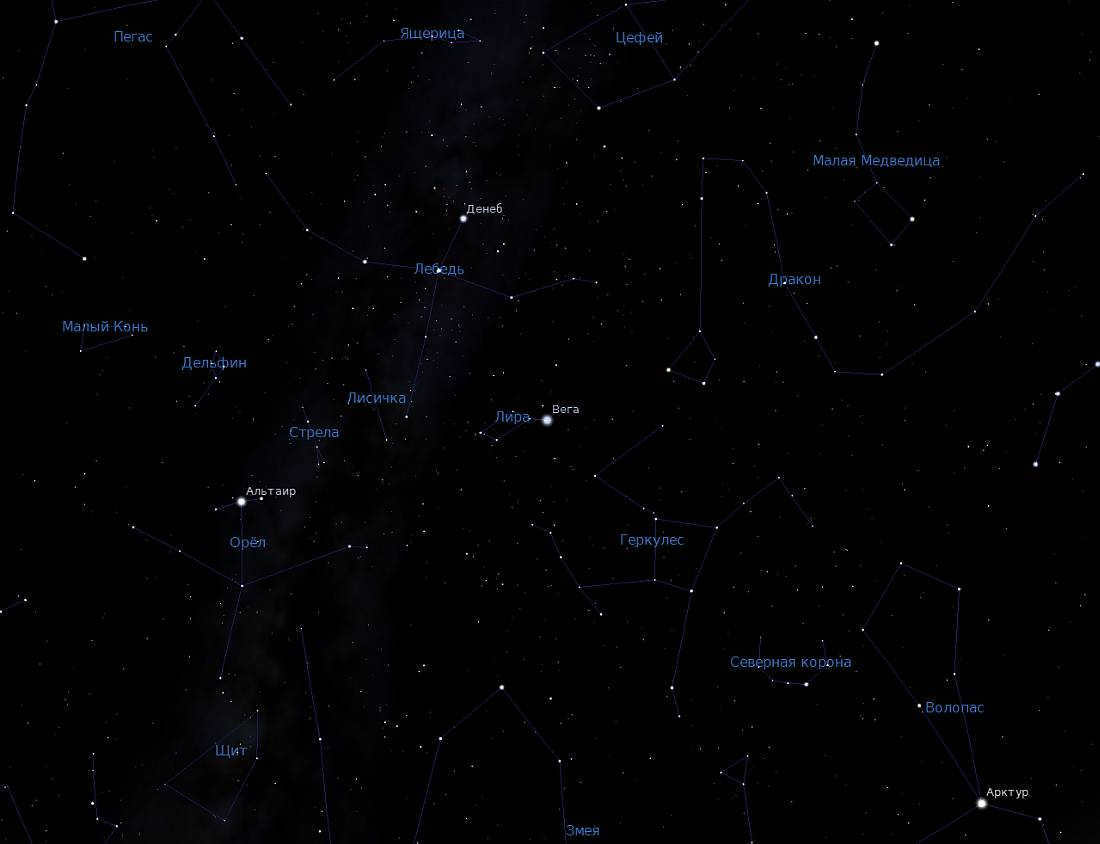
Constellations – image obtained using a planetarium program
Astronomers have observed that the arrangement of stars undergoes gradual changes over time. These changes require several hundred or thousand years to be accurately measured. The night sky presents a seemingly infinite number of celestial bodies, scattered in a seemingly random pattern, which often form constellations. In the visible part of the sky, there are over 3,000 stars that can be seen, while the entire sky contains around 6,000 stars.
Location in plain sight
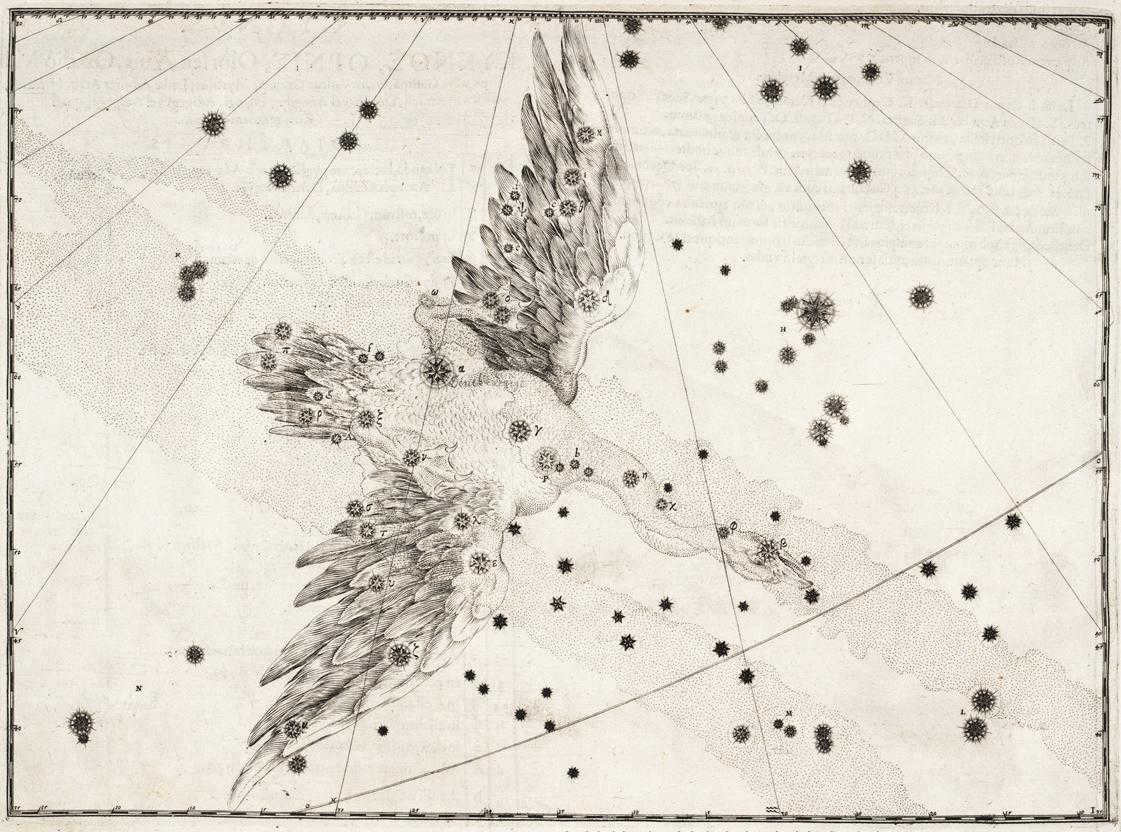

The Swan constellation depicted here is taken from Johann Bayer’s atlas “Uranometria” in 1603.
Observation
During multiple hours of observing the night sky, one can witness the seamless rotation of the celestial sphere, encompassing the stars, around an imperceptible axis. This continuous motion is known as diurnal movement, with the stars appearing to move from left to right.
The Moon, the Sun, and the stars all have their own unique patterns of movement. They all rise in the east, reach their highest point in the southern sky, and then set in the west. However, unlike the stars, the Moon and the Sun have different rising and setting points depending on the time of year. For example, in December, the Sun rises in the southeast and sets in the southwest. Over time, these rising and setting points gradually shift towards the north side of the horizon. As a result, the Sun rises higher above the horizon at noon each day, leading to longer days and shorter nights.
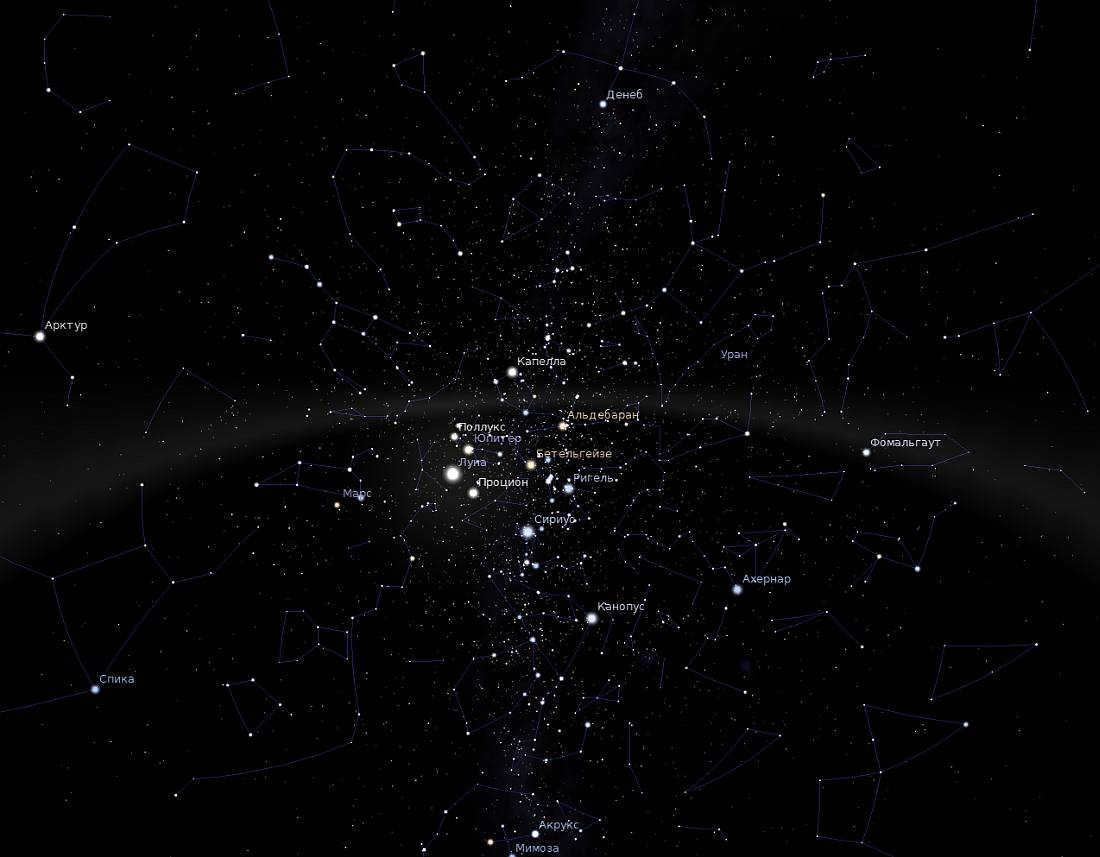
Movement of celestial objects across constellations
Based on the gathered observations, it is evident that the Moon does not remain within a single constellation at all times. Instead, it traverses from one constellation to another, gradually moving from west to east at a rate of 13 degrees per day. Over a span of 27.32 days, the Moon completes a full circle in the sky, passing through all 12 constellations. Similarly, the Sun follows a comparable path to the Moon, albeit at a slower pace of 1 degree per day. The Sun’s entire journey across the constellations spans over the course of a year.
The zodiacs (Pisces, Capricorn, Virgo, Libra, Sagittarius, Scorpio, Leo, Aquarius, Taurus, Gemini, Cancer, Aries) have been assigned to the constellations that the Sun and Moon pass through. In spring, the Sun passes through the first three constellations, followed by the next three in summer, and so on. It is only after six months that the constellations in which the Sun is currently located become visible.
Scientific popular movie “Secrets of the Universe – Constellations”
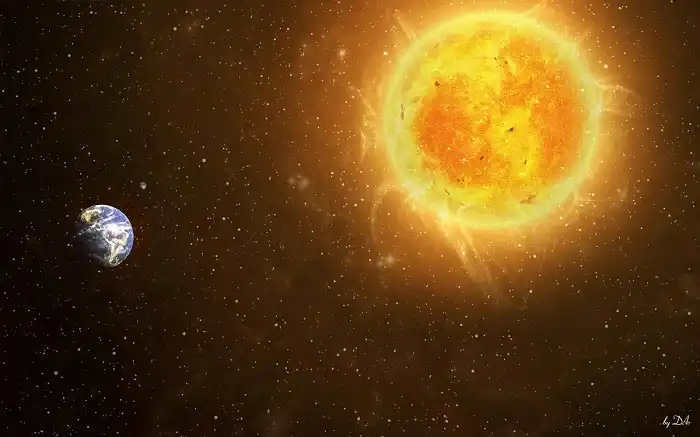
At present, 58,742 educational institutions are eligible for additional cumulative discounts ranging from 2% to 25%. To determine the discount applicable to all staff members of your educational institution, please sign in to your personal Infoworks account.


Enrich your professional skills
Effective planning of educational organization’s operations
We are able to include your educational institution’s discount in addition to this offer (the amount will depend on how many of your colleagues have completed Infoworks courses).
Currently, there are 58,742 educational institutions benefiting from extra discounts (ranging from 2% to 25%). To ascertain the applicable discount for all employees of your educational institution, please sign in to your personal Infoworks account.


Advanced training program
The modern company’s strategy for managing product range and assortment: essential tools for effective management.
We can apply an exclusive discount from your educational institution in addition to our standard discount (the amount of which is determined by the number of your colleagues who have completed Infowrok courses).
Currently, 58,742 educational institutions are eligible for additional discounts ranging from 2% to 25%. To discover the specific discount available for all employees of your educational institution, please log in to your personal Infoworks account.


Teaching Children at Home. Tips and Tricks for Parents
Breakdown of the presentation by individual slides:

Lesson Topic: Stars and Constellations
Presented by:
Svetlana Evgenievna Galkova
Physics Teacher, 1st category
MBOU “School No. 120”
N.Novgorod, Leninsky District

On the second slide, the lesson aims are as follows:
1. Identifying the definition of a star, constellation, and light year.
2. Exploring the primary constellations.
3. Developing skills in working with the PCZN.
4. Acquiring the ability to locate Polaris (the north star) and navigate using it.
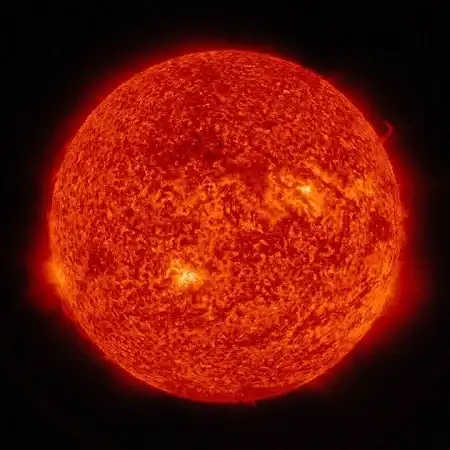
3 slide Homework check
What sets astronomy apart from other natural sciences are its unique objects of study and methods of research.
Can you name different types of celestial bodies?
Observations play a crucial role in astronomy, and they are conducted using various instruments.
How does astronautics contribute to our understanding of the universe?
What distinguishes refractor and reflector optical systems?
Celestial mechanics addresses what kind of problems?
Are you familiar with any domestic or foreign orbiting observatories?
Why is modern astronomy considered as an all-wave science?
Why do we need telescopes when observing the Moon?
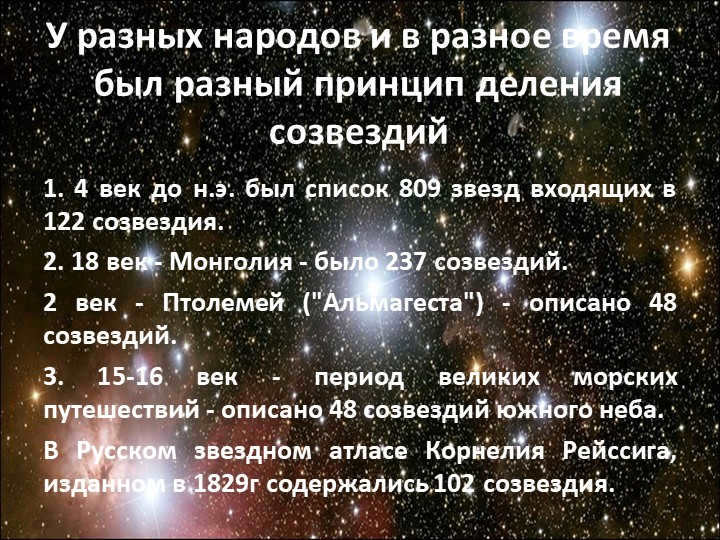
Slide number 4.
Different cultures throughout history have employed various principles in dividing constellations.
1. In the 4th century BC, a list of 809 stars was compiled, which were grouped into 122 constellations.
2. In the 18th century, Mongolia recognized 237 constellations.
During the 2nd century, Ptolemy’s “Almagest” described 48 constellations.
3. During the 15th and 16th centuries, the era of great sea voyages, 48 constellations of the southern sky were documented.
Cornelius Reissig’s Russian Star Atlas, published in 1829, included 102 constellations.

In 1922, the International Astronomical Union made the decision to divide the entire sky into 88 constellations. Then, in 1928, the organization established the definitive boundaries for each constellation.
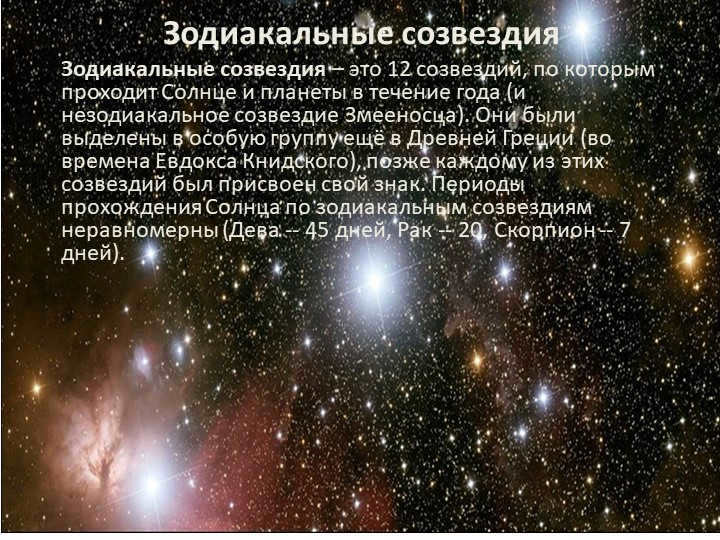

Slide 6: Zodiacal constellations.
The 12 constellations through which the Sun and planets pass during the year are known as the zodiacal constellations (including the non-zodiacal constellation of the Serpentine). In ancient Greece (during the time of Eudoxus of Cnidus), they were identified as a distinct group, and each constellation was later assigned its own sign. The durations of the Sun’s passage through the zodiacal constellations vary (Virgo – 45 days, Cancer – 20 days, Scorpio – 7 days).
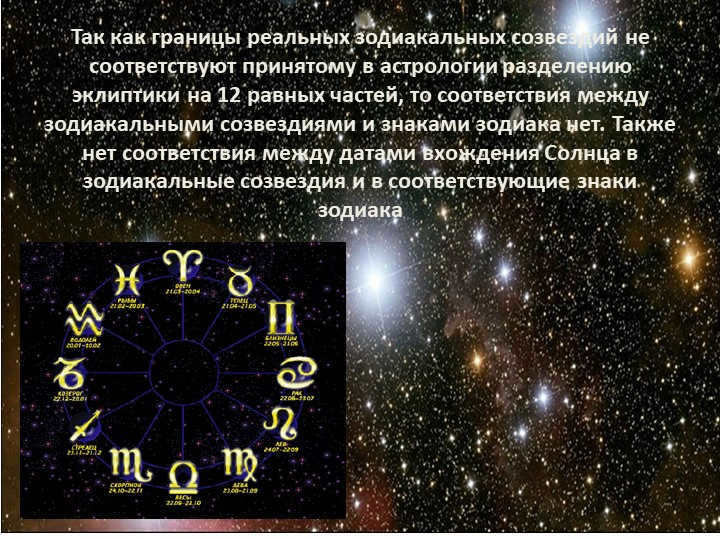

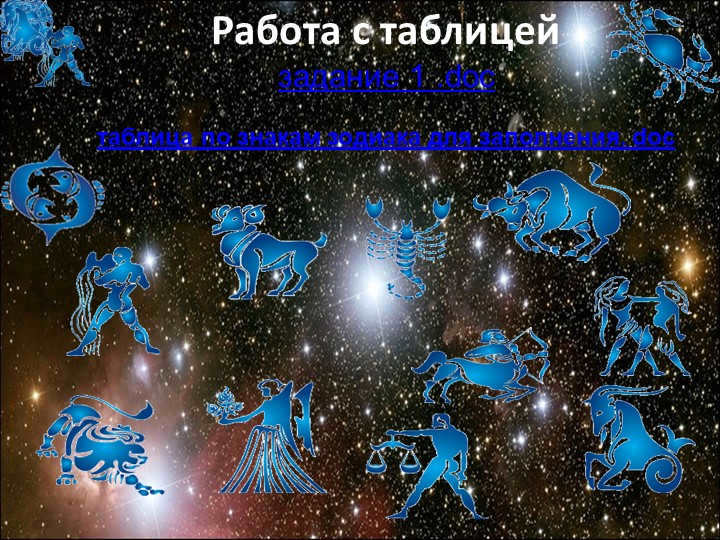
A star is a luminous celestial body made up of gas and held together by its own gravity and internal pressure. It undergoes fusion reactions in its core, resulting in the emission of light and heat. This information is sourced from Wikipedia.

11 slide Task. Represented in the coordinate plane are the points corresponding to the stars in the constellations Big Dipper and Little Dipper.
Constellation
"Ursa Minor."
(6; 6), (– 3; 5.5), (– 8; 5), (0; 7.5),
(3; 7), (– 5; 7), (– 6; 3)
The constellation of the Big Dipper
(– 15; – 7), (– 3; – 6), (3; – 10), (– 6; – 5.5),
(– 10; – 5), (6; – 6), (– 1; – 10)
image .doc
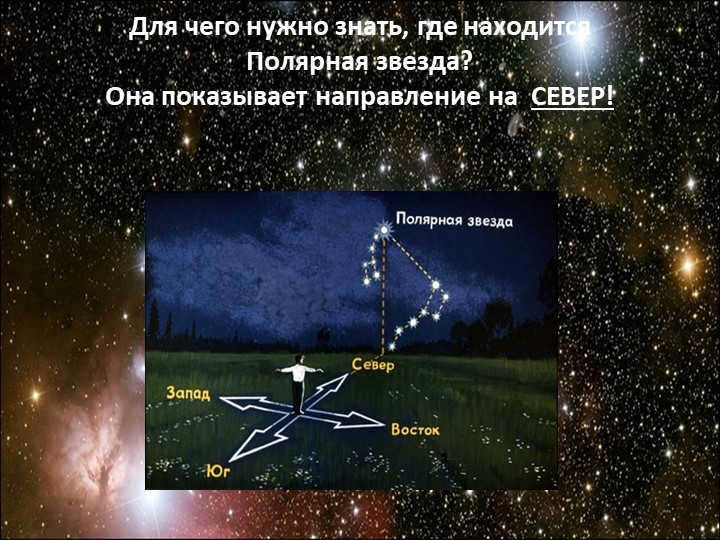
Slide number 12: What is the importance of knowing the location of the polar star?
Can we rely on Polaris?
It indicates the way to the NORTH!
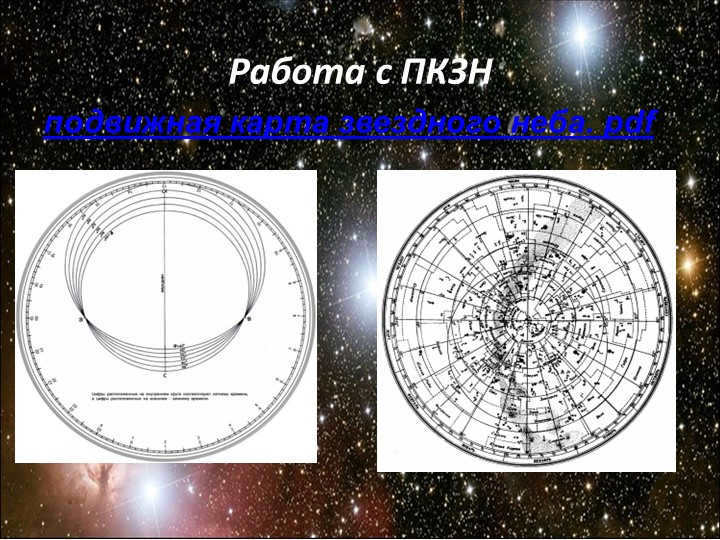
Task 1. Discover the constellations positioned between the northern and southern hemispheres on the evening of October 10th at 9 o’clock.
Task 2. Can the constellations Virgo, Cancer, and Libra be observed at midnight on September 15th? Additionally, which constellation will be in close proximity to the northern horizon at that time?
Task 3. Among the constellations mentioned – The Little Bear, Wolopassus, Ascendant, and Orion – which one will remain visible during the sunset at this latitude?


15 slide The constellation Orion is known as one of the most brilliant and stunning formations in the celestial sphere. It is a truly awe-inspiring sight that mankind has been able to appreciate as we venture into the depths of space using advanced telescopes. This constellation encompasses numerous breathtaking celestial objects.
1. What is the term for a constellation?
2. List the constellations you are familiar with.
3. How are the stars within constellations identified?
4. Identify the brightest star within Orion.
5. What was the purpose of stars in ancient times?
6. What causes the images of constellations to change in the night sky?

For your 16th slide homework assignment, please refer to page 3 of the textbook. Your task is to locate the zodiacal constellation on the PCZN that corresponds to your birth month. Once you have identified the constellation, please answer the following question: When can you observe it and when does it leave your field of vision?


